Day Trips from London
Ultimate Guide to Where to Go and What to See
Planning day trips from London? Our guide makes it easy to explore the best destinations beyond the city. From the historical allure of Windsor Castle to the natural beauty of the Seven Sisters cliffs, we cover how to get there, what to see, and tips for a smooth journey. Whether you’re interested in the academic heritage of Oxford, the architectural wonders of Bath, or the enchanting world of Harry Potter, we provide practical advice on travel times, ticketing, the best times to visit, and more. Get ready to discover all the information you need to enjoy your day trips from London efficiently and enjoyably.
London is a city full of life, history, and endless things to do. But there’s also a whole world to explore just outside the city. These places are perfect for day trips and are easy to get to.
Choosing the best day trips from London can seem tough because there are so many great options. This article is here to help you find the top places to visit for a day out from London. Whether it’s your first visit or you live in London and want to see more of what’s around, we’ve got you covered.
We’ve picked out the absolute best spots for your day trips, mixing famous must-see sites with hidden treasures. This guide is all about making sure you get the most out of your adventures outside London.
We also share tips on how to visit these places on your own and talk about the best day tours from London. While you can reach many destinations by train, sometimes a guided tour can show you much more. Tours let you see more in one day and learn about places in a deeper way, thanks to local guides.
Insider Tip
Don’t miss the map in this article. It shows all the day trip spots we mention, helping you see where everything is and plan your trips easily.
Quick Guide: Day Trip Destinations from London
Historical & Cultural Heritage
- Windsor Castle – The oldest and largest occupied castle in the world, offering a glimpse into British royal history.
- Oxford – Famous for its prestigious university and stunning architecture.
- Bath – Known for its Roman-built baths and beautiful Georgian architecture.
- Cambridge – Another iconic university town with beautiful colleges and the River Cam.
- Canterbury Cathedral & Leeds Castle – A historic cathedral city and a picturesque castle known as “The Loveliest Castle in the World.”
- Stratford-upon-Avon – The birthplace of William Shakespeare, with preserved Tudor-era buildings.
- Arundel Castle – A restored medieval castle offering a mix of architectural styles and extensive gardens.
Natural Landscapes & Coastal Retreats
- The Cotswolds – Known for its charming villages, rolling hills, and rural beauty.
- Brighton & Seven Sisters – A vibrant seaside city and stunning chalk cliffs.
- White Cliffs of Dover & Dover Castle – Iconic white cliffs offering coastal walks and a historic castle.
Unique Attractions & Experiences
- Stonehenge – The prehistoric monument known worldwide for its mysterious origins.
- Harry Potter Warner Bros. Studio Tour – A must-visit for fans, offering a behind-the-scenes look at the Harry Potter films.
- Downton Abbey Filming Locations – Explore the real-life settings of the popular TV series.
- Lacock – A picturesque village often used as a filming location for its preserved historical look.
Royal & Noble Estates
- Hampton Court Palace – Famous for its Tudor architecture, beautiful gardens, and the maze.
- Blenheim Palace – A UNESCO World Heritage Site, birthplace of Winston Churchill, and a masterpiece of English Baroque architecture.
- Warwick Castle – A medieval castle turned interactive museum, showcasing centuries of English history.
Coastal Towns & Ancient Ruins
- Rye and Hastings – Historic towns known for their medieval architecture and coastal views.
- Liverpool & The Beatles – A city synonymous with the Beatles and maritime heritage.
Ready to Explore Further?
After getting a glimpse of the remarkable day trip destinations from London through our quick guide, are you ready to dive deeper? Each location offers its own unique attractions, stories, and experiences waiting to be discovered. Whether you’re drawn to the historical majesty of Windsor Castle, the academic allure of Oxford, or the natural beauty of the Seven Sisters, our detailed guide provides everything you need to plan your adventure.Detailed Day Trip Guide: Discovering the Wonders Beyond London
Embark on a journey beyond the hustle and bustle of the capital with our comprehensive day trip guide. From the enchanting streets of Bath to the prehistoric mysteries of Stonehenge, we’ve curated essential information, including what to see, how to get there, and tips to make the most of your visit. Ready to explore? Let’s uncover the treasures that lie just a short distance from London:
Historical & Cultural Heritage
Windsor Castle
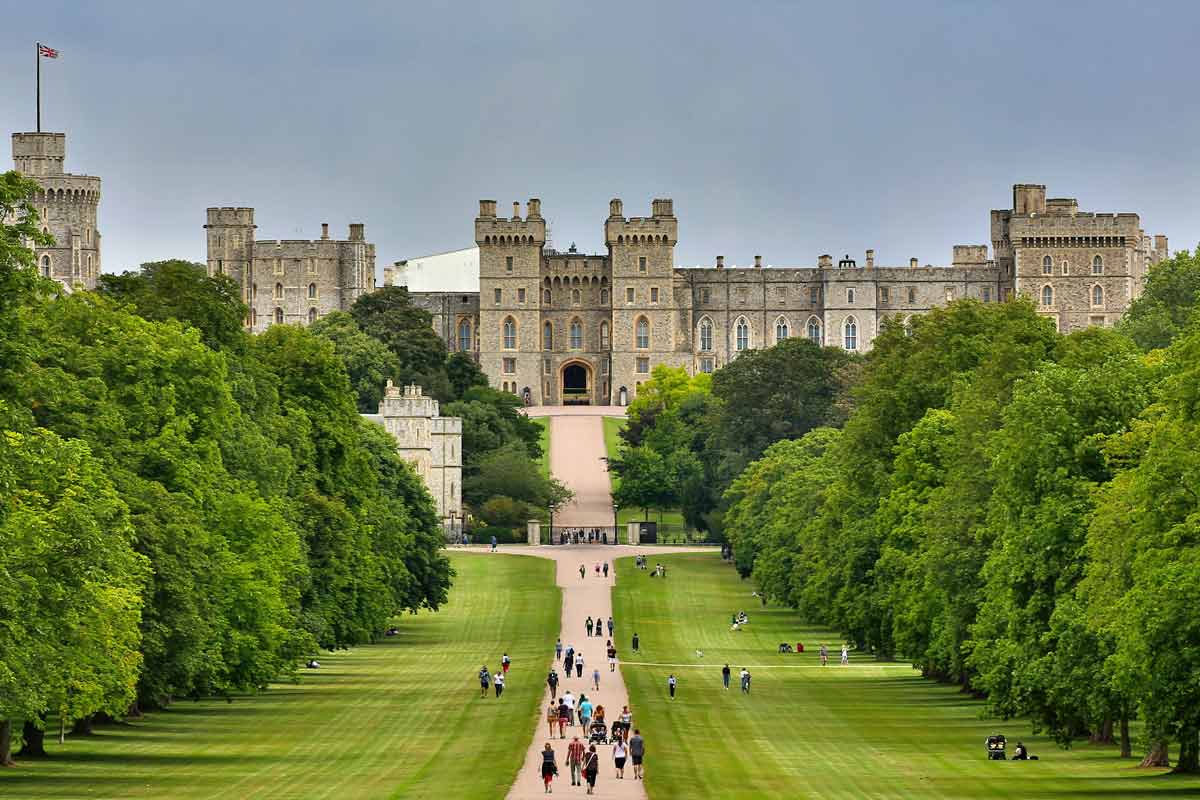
Windsor Castle stands as a monumental testament to British history and royalty, holding the title of the oldest and largest inhabited castle in the world. It serves as one of the official residences of His Majesty The King and showcases a splendid mixture of architectural styles, making it a must-visit destination for anyone interested in the British monarchy, art, and architecture.
Main Attractions
- The State Apartments: Adorned with some of the finest works from the Royal Collection, including paintings by Rembrandt, Rubens, and Canaletto.
- St George’s Chapel: A prime example of Gothic architecture and the site of numerous royal weddings, as well as the resting place of ten monarchs.
- The Changing of the Guard: A quintessential display of British pomp and ceremony, taking place within the castle grounds.
Travel Information
- Getting There: Windsor is easily accessible from London by train, with services running from London Paddington and London Waterloo to Windsor & Eton Central or Windsor & Eton Riverside stations. The journey takes approximately 30 to 50 minutes.
- By Car: Driving from London to Windsor is another option, though parking can be limited in the town centre. The journey typically takes around an hour, depending on traffic.
Best Time to Visit
- Avoiding Crowds: Early morning or late afternoon visits can help avoid the largest crowds, especially during weekends or bank holidays.
- Seasonal Considerations: Spring and summer offer the castle and its grounds at their most vibrant, though Windsor is a year-round destination with each season bringing its own charm.
Tickets and Tours
- Admission Fees: Tickets to Windsor Castle can be purchased online in advance, which is highly recommended to avoid long queues. Discounts are available for students, seniors, and families.
- Guided Tours: While audio guides are included with the admission, private guided tours can also be arranged for a more personalised experience.
- Windsor Castle and Hampton Court Palace Tour: Guided Group Tour. Approx. 10h.
- Stonehenge, Windsor Castle, and Bath from London: Guided Group Tour. Approx. 11h.
- Stonehenge, Windsor Castle and Bath with Pub Lunch in Lacock: Guided Group Tour. Approx. 12h 30min.
- Windsor Castle, Stonehenge & Salisbury Cathedral: Guided Group Tour. Approx. 10h.
Check out more Windsor tours on our Windsor Tours page.
Practical Tips
- Planning Your Visit: Allow at least half a day to explore Windsor Castle thoroughly; however, a full day provides a more relaxed pace to also enjoy the town of Windsor and its surroundings.
- Accessibility: The castle is equipped to welcome visitors with mobility issues, but it’s advisable to check the official website for specific accessibility information before your visit.
Nearby Attractions
- Eton College: Just a short walk across the River Thames, the historic Eton College offers guided tours of its impressive grounds and buildings.
- Windsor Great Park: Covering 5,000 acres, the park offers extensive walking and cycling paths, gardens, and the iconic Long Walk leading up to the castle.
Windsor Castle not only offers a peek into the lives of the British monarchy but also provides visitors with a rich historical and cultural experience. Whether you’re marvelling at the opulent State Apartments, attending a service at St George’s Chapel, or simply enjoying the scenic beauty of Windsor and its surroundings, a trip to Windsor Castle is an unforgettable addition to any London itinerary. Check more information about Things to do in Windsor and Windsor Castle Tours pages. A day out in Legoland Windsor might be a second day on your itinerary.
Oxford
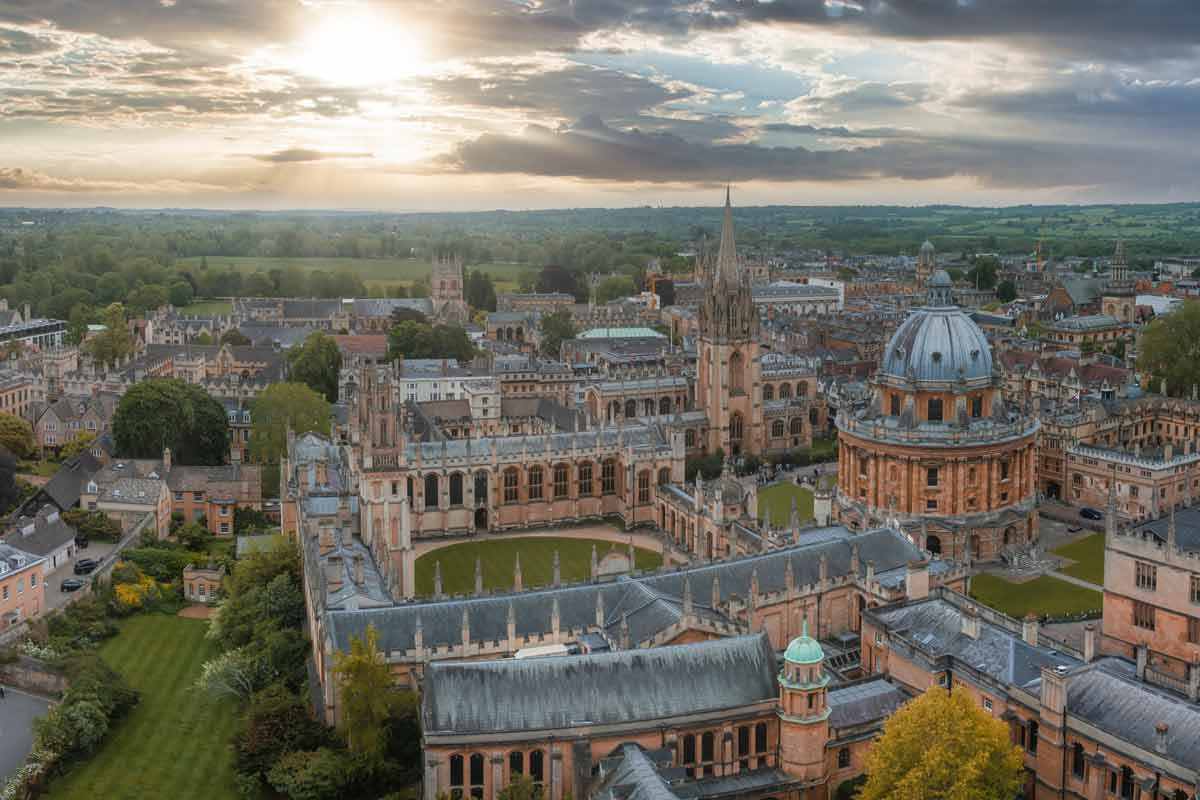
Oxford, the ‘City of Dreaming Spires,’ is renowned worldwide for its prestigious university and stunning historical architecture. This vibrant city offers a blend of ancient academia, rich cultural heritage, and picturesque scenery, making it an essential day trip for those looking to immerse themselves in quintessential British history and charm.
Main Attractions
- The University of Oxford: Explore the historic colleges, each with its own unique character, beautiful quadrangles, and gardens. Notable ones include Christ Church, Magdalen College, and Trinity College.
- Bodleian Library: One of the oldest libraries in Europe, offering guided tours that take visitors through its impressive collection and historic rooms.
- Ashmolean Museum: The UK’s first public museum, which houses a vast collection of art and archaeology spanning world civilizations.
- Punting on the River Cherwell: A quintessential Oxford activity, punting offers a leisurely way to enjoy the city’s beautiful waterways and college backdrops.
Travel Information
- Getting There: Oxford is well-connected to London by train, with services running from London Paddington and London Marylebone to Oxford station. The journey takes approximately an hour.
- By Coach: Frequent bus services like the Oxford Tube and X90 offer direct links between London and Oxford, which can be more economical and just as convenient as train travel.
Best Time to Visit
- Avoiding Crowds: Weekday mornings during term time tend to be quieter, as most students are in lectures or tutorials.
- Seasonal Highlights: Spring and early summer are particularly beautiful when the college gardens and parks are in bloom, though Oxford’s charm is undeniable year-round.
Tickets and Tours
- College Admission: Many colleges charge a small entrance fee for visitors, which is used for the maintenance of the buildings and grounds. Opening times can vary, so it’s best to check in advance.
- Guided Tours: Walking tours led by knowledgeable guides offer insights into the university’s history, famous alumni, and filming locations for movies like Harry Potter.
Oxford University Walking Tour With University Alumni Guide: Guided Group Tour. Approx. 2h.
Oxford, Stratford-upon-Avon and Warwick Castle Day Trip from London: Guided Group Tour. Approx. 10h 30min.
- Oxford, Stratford, Cotswolds & Warwick Castle Tour from London: Guided Group Tour. Approx. 10h 30min.
Practical Tips
- Planning Your Visit: Allocate at least a full day to truly appreciate Oxford’s rich history, architecture, and atmosphere. This allows time to explore the colleges, museums, and perhaps even enjoy a punt on the river.
- Accessibility: Oxford is a historic city with some uneven and cobbled streets. However, many of its attractions, including museums and colleges, are accessible to visitors with mobility issues. It’s advisable to check specific venues in advance for detailed accessibility information.
Nearby Attractions
- Blenheim Palace: Just a short journey from Oxford, this UNESCO World Heritage Site is the birthplace of Sir Winston Churchill and offers stunning gardens and an opulent palace to explore.
- The Cotswolds: Extend your trip with a visit to the picturesque villages and rolling landscapes of the Cotswolds, easily accessible by bus or car from Oxford.
A visit to Oxford is not just a journey through the hallowed halls of education; it’s an exploration of a city where history, tradition, and modernity blend seamlessly. From the awe-inspiring architecture and academia to the tranquil beauty of its green spaces and waterways, Oxford promises a day trip filled with discovery and delight.
Bath
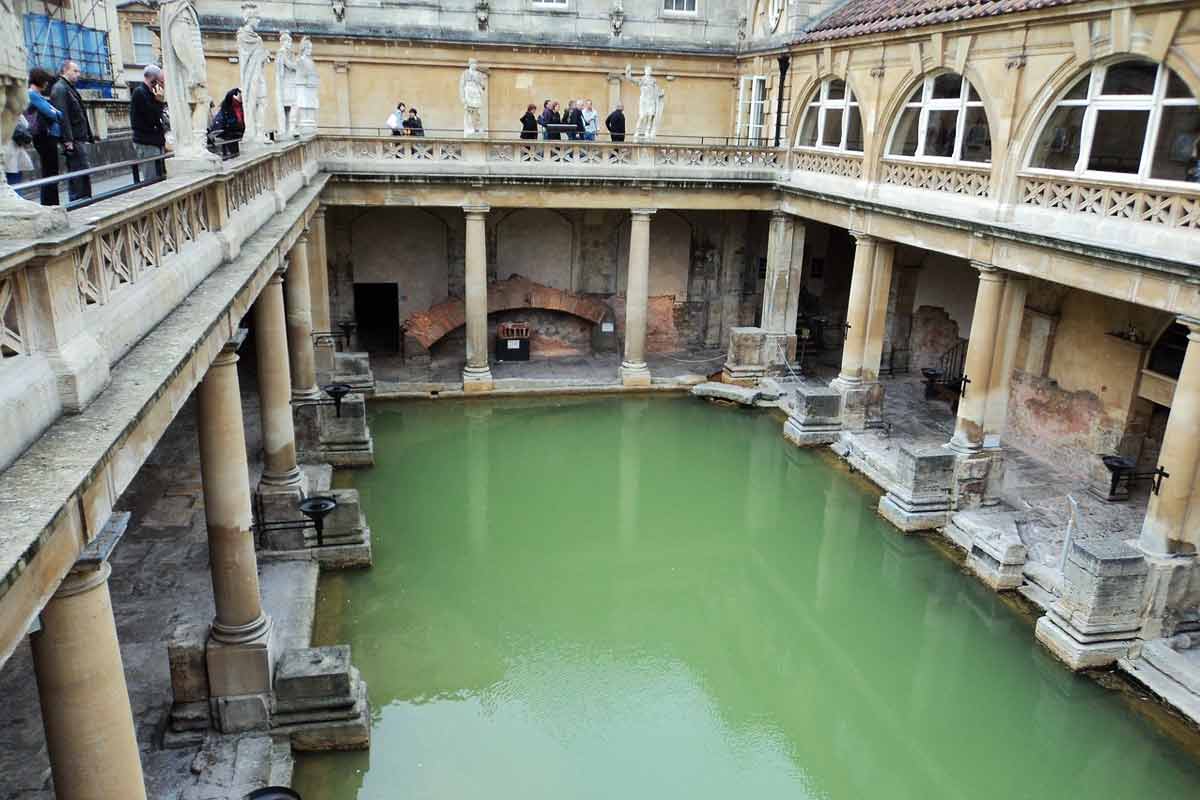
Bath, a UNESCO World Heritage city, is celebrated for its Roman-period baths, exquisite Georgian architecture, and its pivotal role in England’s social history. Nestled in the rolling hills of Somerset, this elegant city offers visitors a unique blend of ancient history, stunning architecture, and vibrant cultural life.
Main Attractions
- The Roman Baths: An ancient spa complex and one of the best-preserved Roman remains in the world, offering a glimpse into the life of the Romans in Britain.
- Bath Abbey: A magnificent example of Perpendicular Gothic architecture with a rich history dating back to the 7th century.
- The Royal Crescent: A sweeping arc of 30 terraced houses laid out in a striking crescent, emblematic of Bath’s Georgian architecture.
- Thermae Bath Spa: The only natural thermal hot springs in Britain that you can bathe in, offering a modern spa experience in a historic city.
Travel Information
- Getting There: Trains run frequently from London Paddington to Bath Spa station, with the journey taking around 1.5 hours. Alternatively, coaches offer a budget-friendly option, though travel times can be longer.
- By Car: Driving from London to Bath takes approximately 2 to 2.5 hours, depending on traffic. However, parking in the city can be limited and expensive.
Best Time to Visit
- Avoiding Crowds: Early morning or late afternoon visits to major attractions like the Roman Baths can help avoid the busiest times, especially during weekends and school holidays.
- Seasonal Beauty: Bath is stunning in the spring when the parks and gardens bloom with flowers and in autumn when the city’s foliage turns vibrant hues.
Tickets and Tours
- Attraction Tickets: It’s wise to book tickets for the Roman Baths and Thermae Bath Spa in advance, especially during peak tourist seasons, to secure entry and avoid long waits.
- Guided Tours: Various walking tours are available, including historical tours, ghost walks, and Jane Austen-themed tours, offering deeper insights into Bath’s rich tapestry of history and culture.
- Stonehenge and Bath Day Trip from London: Guided Group Tour. Approx. 11h 30min.
- Windsor, Stonehenge and Bath Trip from London: Guided Group Tour. Approx. 12h.
Practical Tips
- Planning Your Day: To fully appreciate Bath’s charm, consider spending a full day exploring its historical sites, architecture, and modern attractions. This allows a relaxed pace to also enjoy the city’s shops, cafes, and riverside walks.
- Accessibility: Bath’s historic centre is largely pedestrianized, making it accessible for visitors with mobility issues. However, some historic buildings and areas may have limited access due to their ancient structure.
Nearby Attractions
- Stonehenge: Just an hour’s drive from Bath, Stonehenge is one of the world’s most famous prehistoric monuments and a must-visit for those interested in ancient history.
- The Cotswolds: Extend your visit with a trip to the Cotswolds, known for its picturesque villages and rolling countryside, easily accessible from Bath for a day of exploration.
Bath offers an immersive journey through time, from the days of Roman Britain to the elegance of Georgian society. Its well-preserved historical sites, combined with a thriving contemporary scene, make it an essential destination for those seeking to experience the depth and diversity of British heritage. Whether soaking in the ancient baths, strolling through cobbled streets, or enjoying the city’s lively cultural scene, Bath provides a perfect blend of past and present for an unforgettable day trip from London. Check more information on things to do in Bath page.
Cambridge
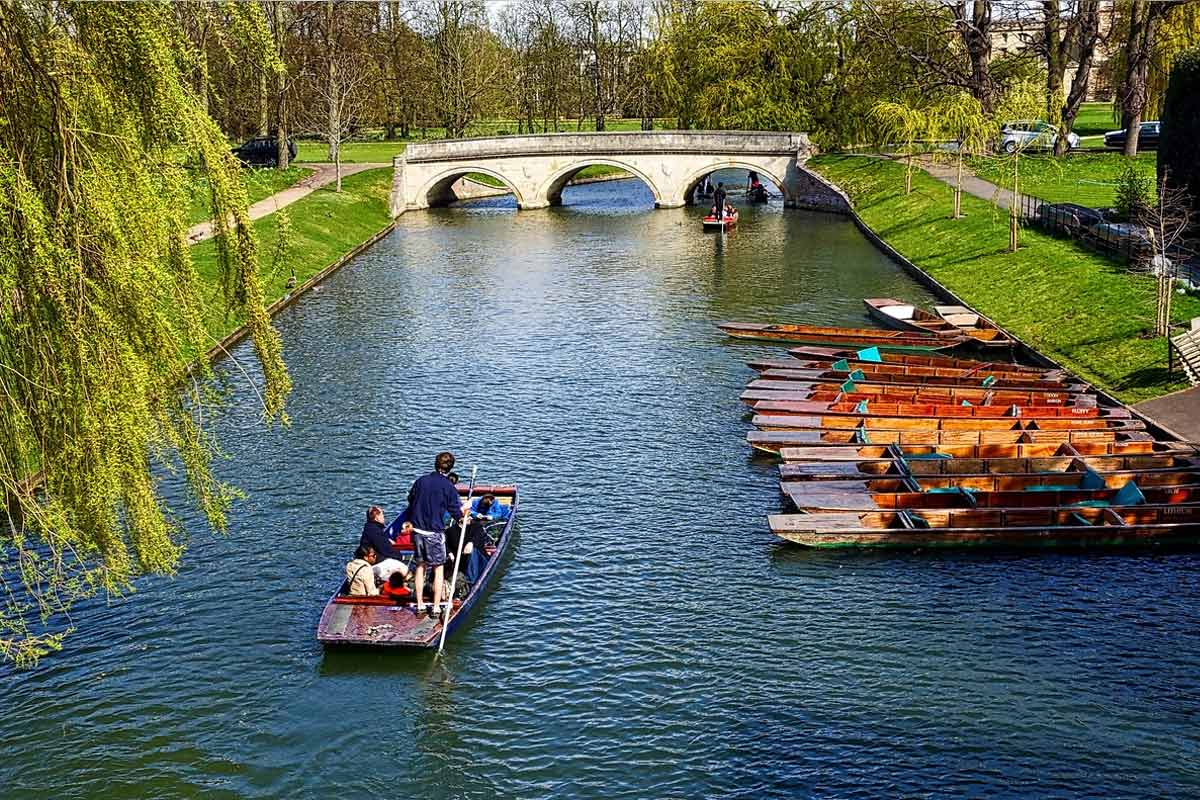
Cambridge, a historic city on the River Cam in Eastern England, is famed for its prestigious university, established in 1209. Renowned for its scholarly achievements, the city is a patchwork of stunning college buildings, medieval architecture, and lush gardens, offering a tranquil yet intellectually vibrant atmosphere.
Main Attractions
- The University of Cambridge Colleges: Explore iconic colleges like King’s College, whose Chapel is a masterpiece of English Gothic architecture, and Trinity College, known for its grand court and historical ties to many great scholars.
- The Fitzwilliam Museum: Home to an impressive collection of art and antiquities, showcasing works from the ancient world to the present day.
- Punting on the Cam: No visit to Cambridge is complete without punting along the River Cam, offering picturesque views of the college “Backs.”
- Mathematical Bridge and The Bridge of Sighs: Two of Cambridge’s most photographed features, both steeped in history and lore.
Travel Information
- Getting There: Direct trains from London King’s Cross and London Liverpool Street reach Cambridge in about an hour, making it an easily accessible day trip. Coaches also run regularly between London and Cambridge, offering a budget-friendly option.
- By Car: Driving from London to Cambridge can take around 1.5 to 2 hours, depending on traffic. Parking in the city centre is limited, so public transport is often more convenient.
Best Time to Visit
- Avoiding Crowds: Weekdays during university term times are less crowded than weekends. Early mornings are also quieter and more conducive to photography.
- Seasonal Visits: Spring and autumn are particularly lovely, as the university parks and gardens are in full bloom or beautifully colored, though Cambridge is charming year-round.
Tickets and Tours
- College Entrance Fees: Some colleges charge entrance fees, which vary. It’s best to check individual college websites for up-to-date information on visiting hours and fees.
- Guided Tours: Consider joining a guided walking tour to learn about the university’s history, famous alumni, and student traditions. Punting tours also offer unique insights from the river.
- Cambridge Day Tour from London: Guided Group Tour. Approx. 9h.
Practical Tips
- Plan Ahead: Research which colleges and museums are open to the public on your chosen day, as some may have restricted access due to university events or exams.
- Accessibility: Cambridge is relatively flat and walkable, with many areas accessible to visitors with mobility issues. However, the cobbled streets and historic buildings may present challenges, so checking accessibility in advance is advisable.
Nearby Attractions
- Grantchester Village: Just a short journey from Cambridge, this picturesque village is ideal for a leisurely walk or a tea break in its famous orchards.
- Ely Cathedral: A magnificent example of Norman architecture, the cathedral is located in the nearby city of Ely, about a 15-minute train ride from Cambridge.
Cambridge offers a serene yet intellectually stimulating environment, rich in history and beauty. From its world-renowned universities and museums to the simple pleasure of a punt down the Cam, Cambridge presents a day trip full of discovery and enchantment for any visitor coming from London.
Canterbury Cathedral & Leeds Castle
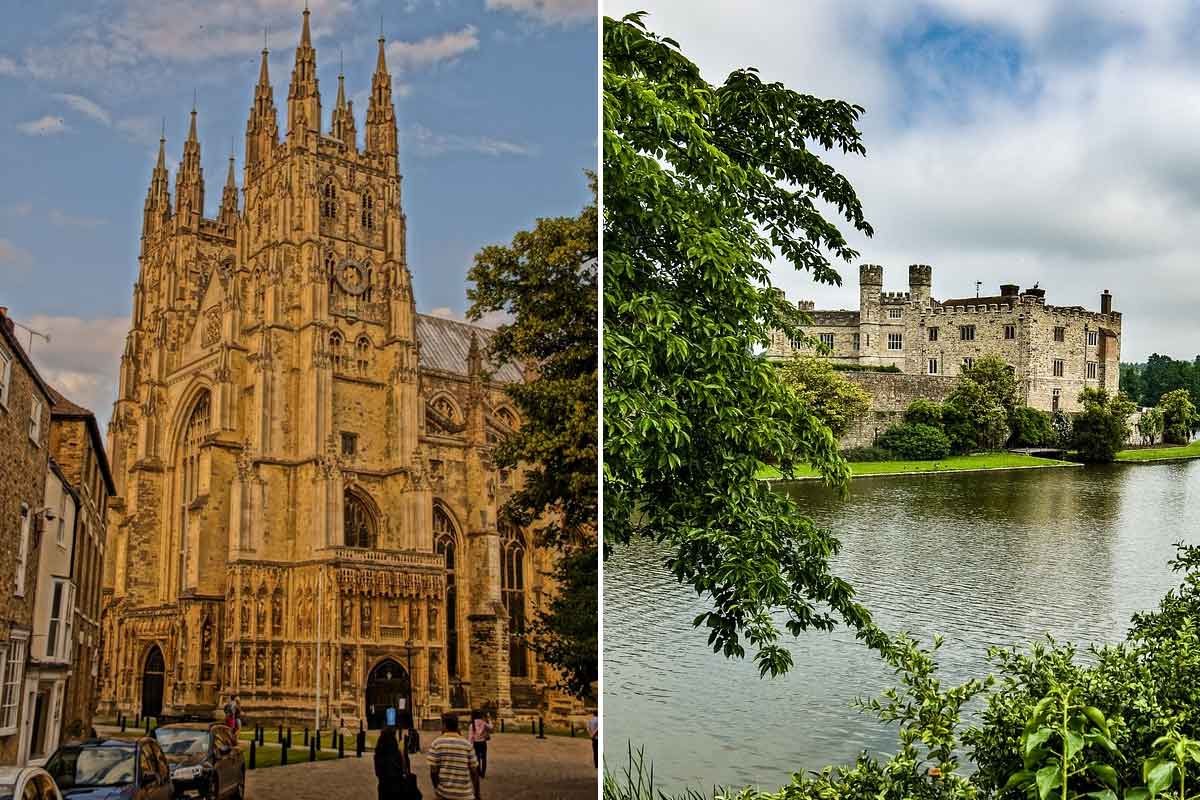
Embarking on a journey to Canterbury and Leeds Castle presents an opportunity to delve into England’s rich history and architectural grandeur. Canterbury, a historic English cathedral city, is famed for its magnificent Canterbury Cathedral, a cornerstone of English Christianity. Leeds Castle, set in the idyllic Kent countryside, is renowned as “the loveliest castle in the world,” boasting over 900 years of history.
Main Attractions
- Canterbury Cathedral: One of the oldest and most famous Christian structures in England, this stunning cathedral is part of a World Heritage Site. It’s known for its breathtaking Gothic architecture and as the site of Archbishop Thomas Becket’s martyrdom.
- Leeds Castle: Situated on two islands on the River Len, Leeds Castle offers visitors the chance to explore its beautifully preserved rooms, extensive gardens, and a maze. The castle’s history spans centuries, serving as a residence for six of England’s medieval queens and a palace used by Henry VIII.
Travel Information
- Getting to Canterbury: Direct trains from London St Pancras International to Canterbury West or from London Victoria to Canterbury East, with journey times of around 1 to 1.5 hours.
- Getting to Leeds Castle: No direct public transport links from London to Leeds Castle. The nearest train station is Bearsted in Kent, and from there, a shuttle service operates to the castle during the summer months. Alternatively, driving from London takes approximately 1.5 hours.
Best Time to Visit
- Avoiding Crowds: Weekday visits are recommended to both destinations to avoid weekend crowds. Early mornings or late afternoons are quieter times to explore.
- Seasonal Highlights: Spring and early summer are ideal for enjoying the gardens at Leeds Castle in full bloom, while Canterbury offers a pleasant atmosphere year-round.
Tickets and Tours
- Entrance Fees: Both Canterbury Cathedral and Leeds Castle charge admission fees, with tickets available for purchase online in advance to save time and sometimes cost.
- Guided Tours: Canterbury Cathedral offers guided tours that delve into its history and significance. Leeds Castle provides both self-guided and guided tour options, allowing visitors to learn about its rich past and extensive grounds.
- Full-day White Cliffs of Dover and Canterbury Cathedral Tour from London: Guided Group Tour. Approx. 11h.
- Canterbury Cathedral, Dover Castle & White Cliffs Guided Day Tour from London: Guided Group Tour. Approx. 10h 30min.
Leeds Castle, Cliffs of Dover and Canterbury Day Trip from London with Guided Cathedral Tour: Guided Group Tour. Approx. 10h
Practical Tips
- Combining Visits: While it’s possible to visit both sites in one day, a rushed schedule might not do justice to each. Consider dedicating a full day to each if time allows, especially to fully appreciate Leeds Castle’s extensive grounds.
- Accessibility: Canterbury Cathedral and Leeds Castle are committed to accessibility for all visitors. However, due to the historic nature of both sites, some areas may have limited access. Check their official websites for detailed accessibility information.
Nearby Attractions
- The Canterbury Tales: An interactive museum that brings Geoffrey Chaucer’s tales to life, located in Canterbury city center.
- The White Cliffs of Dover: If extending your trip, the iconic White Cliffs of Dover are a short drive from Canterbury, offering stunning coastal views and walks.
A visit to Canterbury Cathedral and Leeds Castle offers a deep dive into England’s medieval history, architectural beauty, and the stories that shaped the nation. Whether marveling at the spiritual ambiance of Canterbury or exploring the royal heritage of Leeds Castle, these destinations provide a captivating experience for history enthusiasts and casual visitors alike.
Combined Visit to Canterbury Cathedral & Leeds Castle
Getting There & Planning Your Visit
Starting your day trip from London, you have two stunning locations to cover: the historic Canterbury Cathedral in the heart of Canterbury, and the majestic Leeds Castle set in the Kent countryside. Given their geographical locations and what each has to offer, here’s the recommended order and travel options:
Morning: Leeds Castle
- Why Start Here: Leeds Castle opens early, allowing you to enjoy its grounds, gardens, and interior before it gets busier in the afternoon. The castle offers a tranquil start to the day with its picturesque landscapes and historic rooms.
- Getting There from London: Driving is the most straightforward option, taking approximately 1.5 hours from London. There are no direct public transport links to Leeds Castle from London, but you can take a train to Bearsted Station and catch a shuttle bus to the castle during the summer months.
Afternoon: Canterbury Cathedral
- Travel to Canterbury: After exploring Leeds Castle, head to Canterbury, which is about a 30-minute drive away. If relying on public transport, return to Bearsted Station, take a train to Canterbury. This segment of the journey may require a transfer, so check the train schedules in advance.
- Why Visit Next: Canterbury Cathedral, as a significant historical and religious site, offers a reflective counterpoint to the morning’s exploration. The Cathedral closes later than Leeds Castle, giving you ample time to explore the site and the surrounding medieval city.
Tips for a Combined Visit
- Check Opening Times: Verify the opening hours for both attractions, as they can vary seasonally. Plan to arrive at Leeds Castle for opening and allocate sufficient time to reach Canterbury Cathedral before it closes.
- Lunch Options: Consider having lunch at Leeds Castle or in one of the quaint villages or towns between Leeds Castle and Canterbury to break up the journey and enjoy some local cuisine.
- Stay Efficient: To make the most of your time, particularly if travelling by public transport, research and plan your train or bus schedules carefully, allowing for travel time and any necessary transfers.
Travel Options Between Leeds Castle and Canterbury
- By Car: The easiest and most flexible option, allowing direct travel between the two sites without worrying about train or bus schedules.
- Public Transport: Requires returning to Bearsted Station from Leeds Castle, then taking a train to Canterbury. Be prepared for transfers and a potentially longer journey time.
Tours – Most Convenient Option
- xx
Stratford-upon-Avon
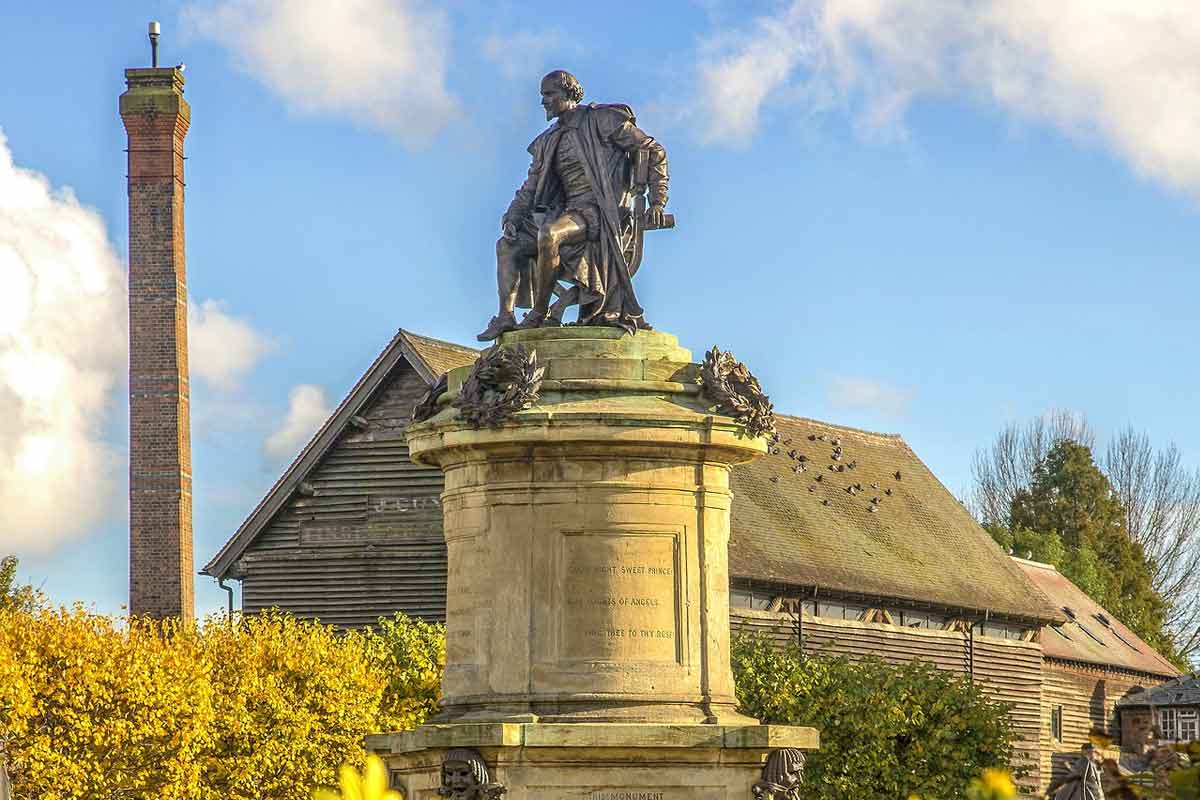
Stratford-upon-Avon, the birthplace of William Shakespeare, is steeped in cultural and literary history, making it an indispensable stop for those exploring the heart of England. This charming market town not only celebrates its most famous resident but also offers visitors a glimpse into Tudor England amidst its beautifully preserved heritage and tranquil riverside setting.
Main Attractions
- Shakespeare’s Birthplace: Explore the house where the world’s most famous playwright was born and grew up, now a museum filled with artefacts and exhibits about his life.
- Royal Shakespeare Theatre: Catch a performance by the Royal Shakespeare Company in this iconic venue that stages world-class productions of Shakespeare’s plays.
- Anne Hathaway’s Cottage: Visit the picturesque farmhouse where Shakespeare’s wife lived before their marriage, surrounded by beautiful gardens.
- Hall’s Croft: The elegant Jacobean home of Shakespeare’s daughter, Susanna, and her husband, Dr. John Hall, showcasing 16th and 17th-century furnishings and a medicinal herb garden.
Travel Information
- Getting There: Stratford-upon-Avon is well-connected by train from London Marylebone, with a journey time of approximately 2 hours. Alternatively, coach services offer direct routes from London to Stratford-upon-Avon.
- By Car: Driving from London takes around 2 to 2.5 hours, depending on traffic. The town is located near major motorways, making it an easy drive from the capital.
Best Time to Visit
- Avoiding Crowds: Weekdays outside of school holidays typically offer a quieter experience. Early morning or late afternoon is the best time to visit the Shakespearean houses to avoid peak crowds.
- Seasonal Events: Stratford-upon-Avon hosts various festivals and events throughout the year, including the Stratford-upon-Avon Literary Festival and Shakespeare’s birthday celebrations in April, adding extra allure to visits during these times.
Tickets and Tours
- Shakespeare’s Family Homes: Tickets can be purchased individually for each house or as a combined ticket for entry to multiple properties, often at a discount. Booking online in advance can save time and money.
- Guided Tours: Walking tours of the town and themed Shakespeare tours offer insightful commentary on the playwright’s life and works, as well as the history of Stratford-upon-Avon.
Practical Tips
- Planning Your Day: Allocate a full day to comfortably explore Stratford-upon-Avon’s attractions, especially if you plan to see a play at the Royal Shakespeare Theatre.
- Accessibility: The town is generally accessible, with many attractions offering facilities for visitors with disabilities. However, due to the historic nature of some buildings, access may be limited in places. It’s advisable to check in advance with specific venues.
Nearby Attractions
- The Cotswolds: Just a short drive from Stratford-upon-Avon, the Cotswolds Area of Outstanding Natural Beauty offers picturesque villages, scenic walks, and quintessentially English countryside.
- Warwick Castle: Located about 20 minutes by car from Stratford-upon-Avon, this impressive medieval castle offers a fascinating journey through Britain’s history, with interactive exhibits and stunning grounds.
Stratford-upon-Avon presents a captivating mix of literary heritage, historic architecture, and performing arts, all set against the backdrop of England’s enchanting countryside. Whether you’re a Shakespeare aficionado or simply looking to explore one of England’s most picturesque towns, Stratford-upon-Avon promises a memorable day trip filled with culture, history, and beauty.
Arundel Castle
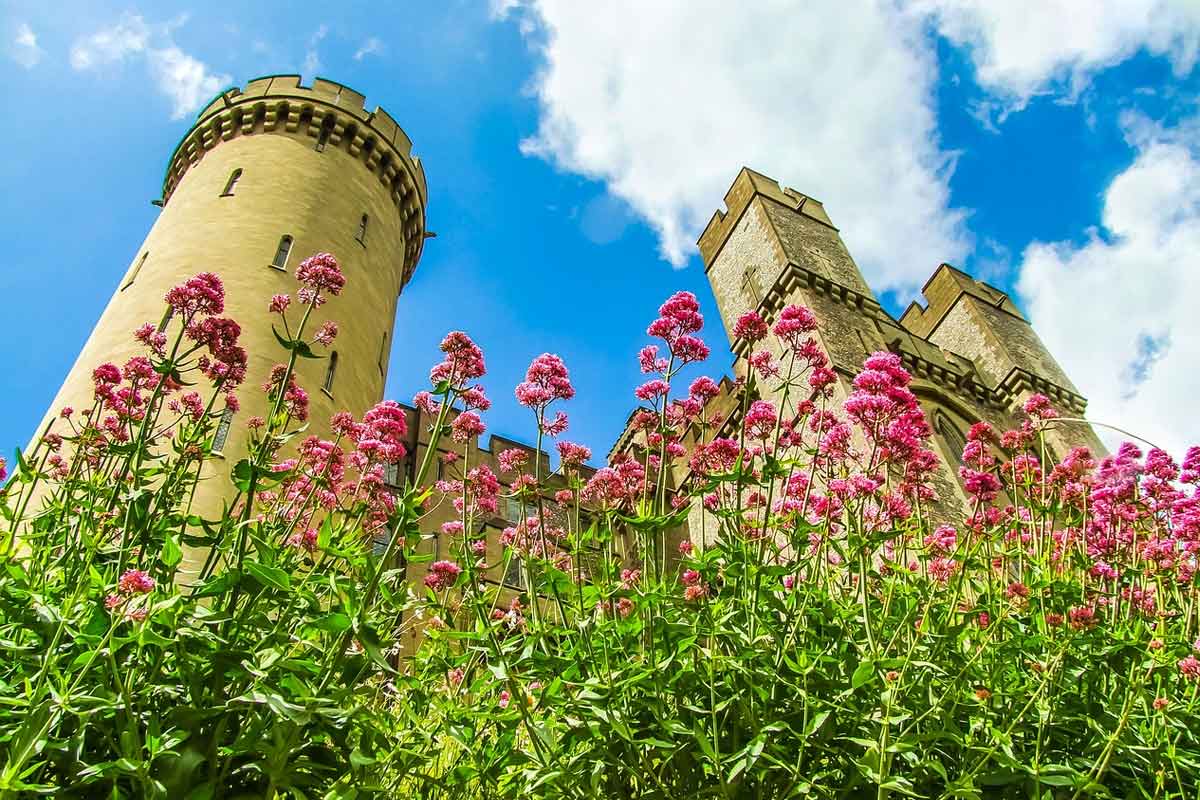
Arundel Castle, nestled in the lush landscapes of West Sussex, stands as a monumental beacon of England’s medieval past and architectural evolution. With origins dating back to the Norman Conquest, the castle has been the family home of the Dukes of Norfolk for over 400 years, offering visitors a rich tapestry of history, art, and spectacular gardens.
Main Attractions
- Castle Keep and Gardens: Explore the ancient Norman Keep, the heart of the castle, offering panoramic views of the surrounding countryside. The meticulously maintained gardens are a highlight, with themed areas including the Collector Earl’s Garden.
- State Rooms: The castle’s interior is a showcase of opulent design, featuring fine art, period furniture, and detailed tapestries that narrate the family’s history and the castle’s role through the centuries.
- Special Events: Arundel Castle hosts a variety of events throughout the opening season, including medieval jousting tournaments, historical reenactments, and garden shows, adding an extra layer of excitement to visits.
Travel Information
- Getting There: Arundel is accessible by train from London Victoria, with a journey time of approximately 1.5 hours. The castle is a short walk from Arundel Station. For those preferring to drive, it takes around 1 hour and 45 minutes from London, with parking available in the town.
- By Car: Driving offers flexibility to explore the surrounding areas of West Sussex, including the South Downs National Park.
Best Time to Visit
- Avoiding Crowds: Weekday visits tend to be quieter, allowing for a more leisurely exploration of the castle and its grounds.
- Seasonal Beauty: The castle and gardens are particularly striking from April to June when the gardens are in full bloom, and the landscape is vibrant. However, the castle’s opening times vary seasonally, so it’s essential to check in advance.
Tickets and Tours
- Admission Fees: Tickets can be purchased at the castle or online in advance. There are various ticket options, including entry to just the gardens or a full access ticket to the castle and grounds.
- Guided Tours: While the castle offers informational guides, specific guided tours can be arranged in advance for groups, providing a deeper understanding of its history and architecture.
Practical Tips
- Planning Your Visit: Allocate at least half a day to fully appreciate the castle, its interiors, and the gardens. If you’re attending a special event, plan to spend the whole day.
- Accessibility: The castle’s historic nature means that access can be limited in certain areas. The gardens and ground floor rooms are accessible, but it’s advisable to check the official website or contact the castle directly for specific accessibility information.
Nearby Attractions
- Arundel Town: This charming market town offers quaint shops, cafes, and the beautiful Arundel Cathedral, just a short walk from the castle.
- South Downs National Park: For nature enthusiasts, the nearby South Downs offer beautiful landscapes, walking trails, and country pubs, perfect for extending your visit to the area.
Arundel Castle provides a fascinating journey through England’s medieval history, set within a landscape of natural beauty. Its blend of historical significance, architectural splendor, and engaging events make it an enriching day trip from London, appealing to history buffs, garden lovers, and families alike.
When was the Norman Conquest?
The Norman Conquest of England began in 1066, following the Battle of Hastings on October 14th of that year, when William, the Duke of Normandy (later known as William the Conqueror), defeated King Harold II of England. This event marked the beginning of Norman rule in England. This period, from 1066 to 1154, spans 88 years. However, the influence of Norman culture, architecture, and governance continued to shape English society long beyond the end of direct Norman rule.Natural Landscapes & Coastal Retreats
The Cotswolds
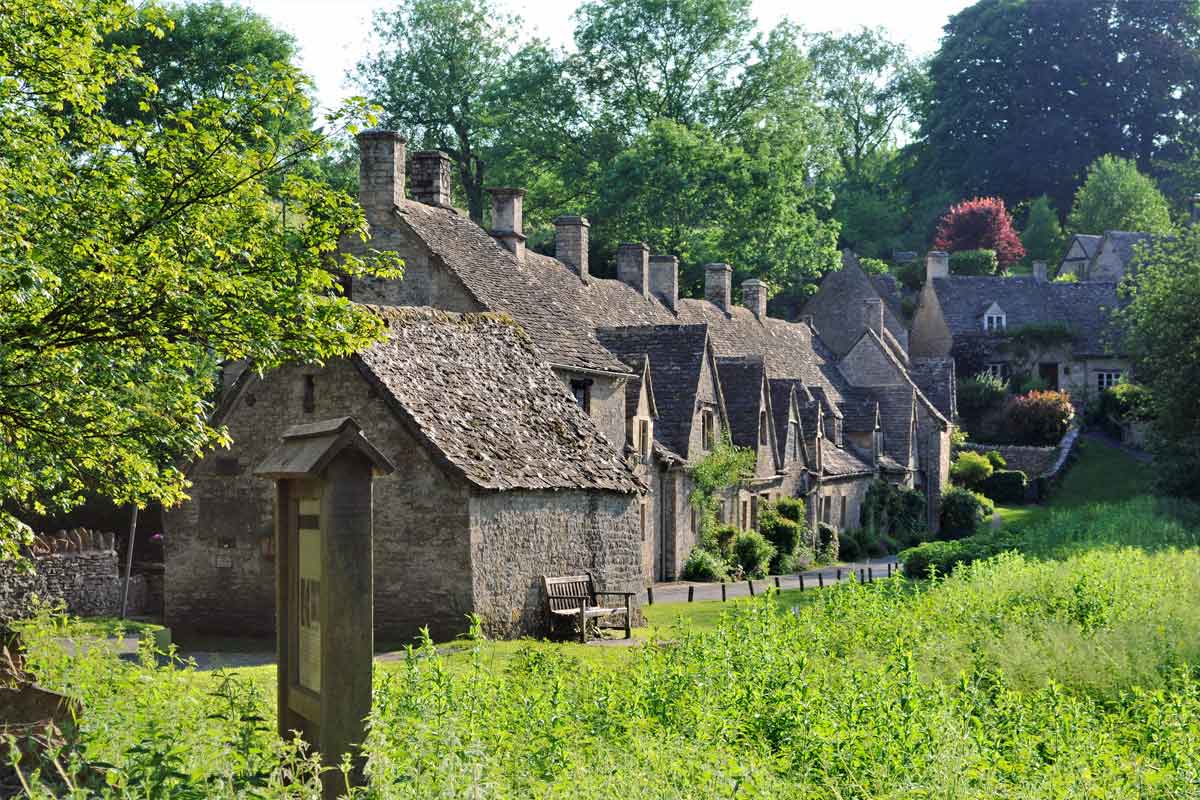
The Cotswolds, designated an Area of Outstanding Natural Beauty (AONB), is famed for its picturesque English countryside, charming villages built from honey-coloured stone, and rolling green hills. Stretching across several counties in south-central England, this idyllic region offers a peaceful retreat from the hustle and bustle of city life, making it a perfect day trip destination from London for those seeking natural beauty and a glimpse into traditional English rural life.
Main Attractions
- Quaint Villages: Explore iconic Cotswold villages such as Bourton-on-the-Water, often referred to as the ‘Venice of the Cotswolds’, and Bibury, acclaimed by William Morris as the most beautiful village in England.
- Historic Market Towns: Visit market towns like Chipping Campden and Stow-on-the-Wold, which are rich in history and offer a variety of independent shops, traditional pubs, and tea rooms.
- Countryside Walks: The Cotswolds Way offers over 100 miles of walking paths that meander through the countryside, providing stunning views and the chance to enjoy the region’s natural beauty.
- Gardens and Estates: Discover the region’s grand estates and gardens, such as Hidcote Manor Garden and Blenheim Palace, a UNESCO World Heritage Site near the Cotswolds.
Travel Information
- Getting There: While public transport options are available, including trains to key towns like Moreton-in-Marsh and buses connecting various villages, the best way to explore the Cotswolds is by car. This offers the flexibility to visit multiple villages and sights at your own pace.
- By Car: Driving from London to the Cotswolds takes approximately 1.5 to 2 hours, depending on your destination within the region.
Best Time to Visit
- Avoiding Crowds: To avoid the peak tourist season, consider visiting in the shoulder months of April-May or September-October, when the weather is pleasant, and the region is less crowded.
- Seasonal Beauty: Each season offers its own charm, from the blossoms of spring and the lush greenery of summer to the golden hues of autumn and the serene beauty of winter.
Tours
- Cotswolds Small Group Tour from London: Guided Small Group (16max) Tour. Approx. 10h.
- Oxford and Traditional Cotswolds Villages Small-Group Day Tour from London: Guided Small Group (16max) Tour. Approx. 10h.
- The Cotswolds and Blenheim Palace: Guided Group Tour. Approx. 10h.
Practical Tips
- Planning Your Route: Decide on which villages and attractions you’d like to visit in advance and plan your route accordingly. The Cotswolds covers a large area, so prioritising is key to making the most of your day trip.
- Staying Longer: If time allows, consider staying overnight in one of the charming B&Bs or country inns to fully immerse yourself in the tranquillity of the countryside.
Nearby Attractions
- Stratford-upon-Avon: The birthplace of William Shakespeare is just a short drive from the northern part of the Cotswolds, offering cultural and historical insights alongside your countryside exploration.
- Oxford: Located on the eastern edge of the Cotswolds, Oxford provides a perfect combination of architectural beauty, academic heritage, and bustling city life.
The Cotswolds represents the quintessential English countryside, offering a blend of natural beauty, historic architecture, and traditional rural culture. Whether you’re wandering through its quaint villages, enjoying a leisurely lunch in a centuries-old pub, or taking in the scenic landscapes on a countryside walk, a trip to the Cotswolds provides a peaceful and picturesque escape from London.
A Few of the Cotswolds' Shops Worth Mentioning
The Cotswold Cheese Company
- Location: Moreton-in-Marsh
- What It Offers: A wide selection of local and international cheeses, with a focus on artisanal and farmhouse varieties.
- Why Visit: Cheese lovers can indulge in tastings and discover new favorites, with knowledgeable staff to guide their choices.
Octavia’s Bookshop
- Location: Cirencester
- What It Offers: An award-winning independent bookshop specializing in children’s books but offering selections for all ages.
- Why Visit: For personalized recommendations and a cozy atmosphere that encourages lingering and browsing.
Keith Harding’s World of Mechanical Music
- Location: Northleach
- What It Offers: A fascinating collection of self-playing musical instruments, from music boxes to orchestrions.
- Why Visit: To experience live demonstrations of antique musical instruments and uncover a unique slice of musical history.
Huffkins
- Location: Several, including Burford and Stow-on-the-Wold
- What It Offers: A traditional bakery and tea room serving up handmade cakes, pastries, and the famous lardy cake.
- Why Visit: For a taste of traditional Cotswolds baking and a relaxing tea room experience in a picturesque setting.
Brighton & Seven Sisters
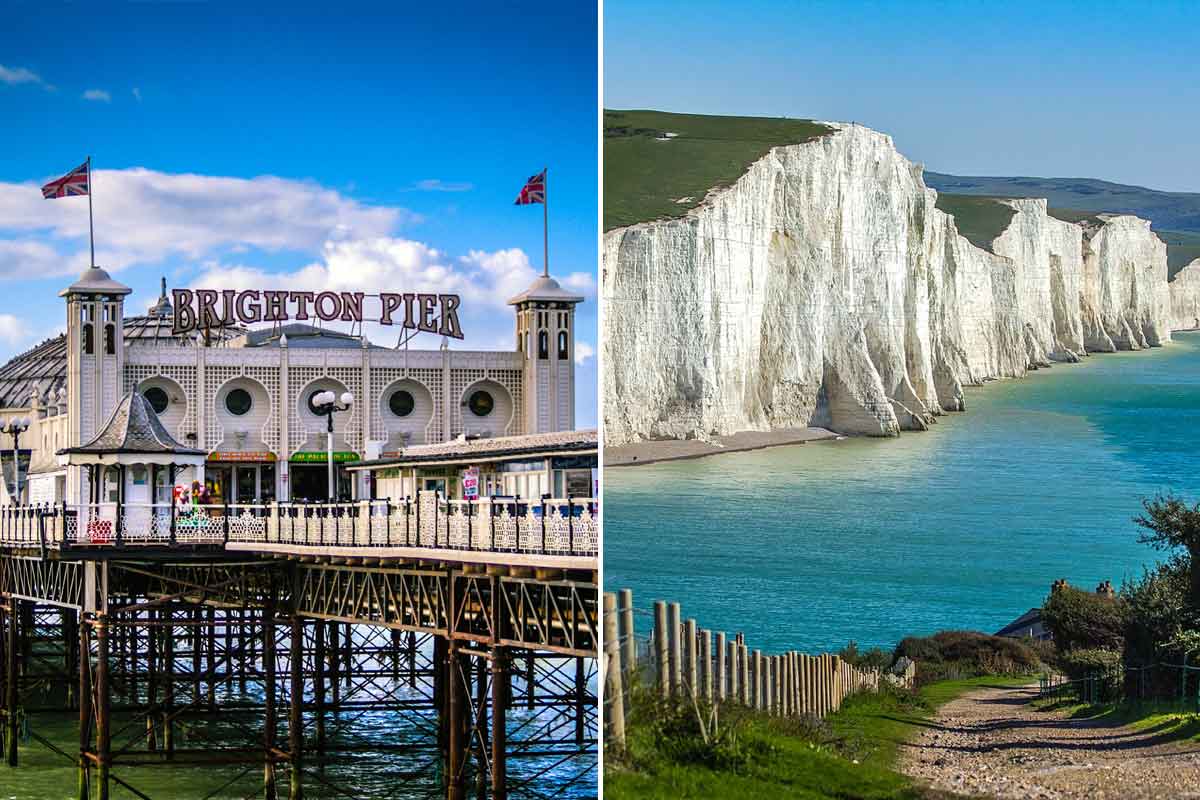
Brighton and the Seven Sisters cliffs offer a perfect combination of urban vibrancy and natural beauty for day-trippers from London. Brighton, known for its lively seaside atmosphere, eclectic lanes, and rich cultural scene, contrasts beautifully with the serene and dramatic landscapes of the Seven Sisters, pristine chalk cliffs along the Sussex coast.
Main Attractions
Brighton
- Brighton Pier: A symbol of the seaside resort with amusements, rides, and traditional stalls.
- The Royal Pavilion: An exotic palace with a blend of Asian architectural styles, once a royal residence.
- The Lanes & North Laine: Historic alleyways and bohemian streets filled with independent shops, cafes, and street art.
Why Visit: Brighton’s diverse attractions, from cultural sites to its pebble beach and vibrant nightlife, make it a dynamic destination. It’s ideal for those looking to experience the quintessential British seaside as well as unique shopping and dining options.
Seven Sisters
- Seven Sisters Country Park: Offers stunning views of the chalk cliffs, opportunities for walks along the coast, and bird watching.
- Beachy Head: The highest chalk sea cliff in Britain, providing spectacular seaside vistas.
Why Visit: For nature lovers and outdoor enthusiasts, the Seven Sisters offer breathtaking natural landscapes, challenging hikes, and the chance to escape into tranquility away from the city hustle.
Getting There
- Brighton: Direct trains from London to Brighton are frequent, with a journey time of about an hour, making it easily accessible for a day trip.
- Seven Sisters: From Brighton, the easiest way to reach the Seven Sisters is by car or bus. The journey can take around an hour by road, depending on the specific area you’re visiting within the Seven Sisters Country Park.
Best Time to Visit
- Brighton: Spring to early autumn is ideal, with warmer weather perfect for beach visits and outdoor activities. However, Brighton’s cultural sites and indoor attractions make it a year-round destination.
- Seven Sisters: Late spring through early autumn offers the best conditions for hiking and enjoying the coastal views. Summer provides longer daylight hours for exploring the cliffs and surrounding countryside.
Practical Tips
- Plan Your Visit: Check the weather forecast and tide times if you plan to walk near the coast or explore the beach areas.
- Wear Appropriate Clothing: The British weather can be unpredictable. Bring layers and wear comfortable shoes, especially if you’re planning to hike around the Seven Sisters.
- Brighton Parking: Parking can be challenging and expensive in Brighton. Using public transport or park-and-ride services is advisable.
Brighton and the Seven Sisters present a wonderful contrast of experiences, from the lively and colourful city life of Brighton to the natural, untouched beauty of the Sussex coast. Whether you’re interested in cultural exploration, shopping, dining, or simply enjoying some of the UK’s most stunning landscapes, this combination offers a fulfilling day out for all.
How to Combine Your Visit to the Seven Sisters and Brighton?
Combining a visit to Brighton and the Seven Sisters cliffs into a single day trip from London involves careful planning to ensure you experience the best of both the vibrant seaside city and the stunning natural beauty of the cliffs. Here’s how to make the most of your combined visit:
Morning: Start with the Seven Sisters
- Timing: Aim to start your day early. Leaving London by around 8 AM allows you to reach the Seven Sisters by 10 AM, giving you the cooler part of the day to explore the cliffs.
- Getting There: If you’re driving, head directly to the Seven Sisters Country Park for parking. Public transport users can take a train to Brighton and then catch a bus towards Eastbourne, alighting near the Seven Sisters for a walk.
- Exploring: Dedicate the morning to walking part of the South Downs Way for breathtaking views of the cliffs and the English Channel. Plan for a 2-3 hour visit to enjoy a scenic walk and take photographs.
Afternoon and Evening: Brighton
- Travel to Brighton: Around midday, head towards Brighton. If you’re using public transport, buses run from the Seven Sisters area back to Brighton. By car, the drive takes approximately an hour.
- Lunch in Brighton: Upon arrival, enjoy lunch at one of Brighton’s many eateries, ranging from seaside fish and chips to international cuisines in the city center.
- Brighton Attractions: Spend the afternoon exploring Brighton’s highlights. Walk along the beachfront, visit the Royal Pavilion, and browse the shops in The Lanes.
- Evening: Conclude your day with a relaxing dinner in Brighton and a sunset stroll along the pier or beach, weather permitting.
Tips for a Successful Combined Visit
- Check Timetables: If using public transport, verify train and bus schedules in advance to ensure smooth connections.
- Wear Comfortable Footwear: You’ll be walking a lot, both on the rural trails at the Seven Sisters and on city streets in Brighton.
- Pack Essentials: Bring sunscreen, water, snacks, and a camera. For the cliffs, a hat and windbreaker might be necessary, as it can be breezier than in the city.
- Be Mindful of Time: Keep an eye on the time, especially if you’re relying on public transport to return to London.
- Sunset at Brighton Beach: If time and weather allow, watching the sunset from Brighton Beach can be a beautiful way to end your day.
White Cliffs of Dover & Dover Castle
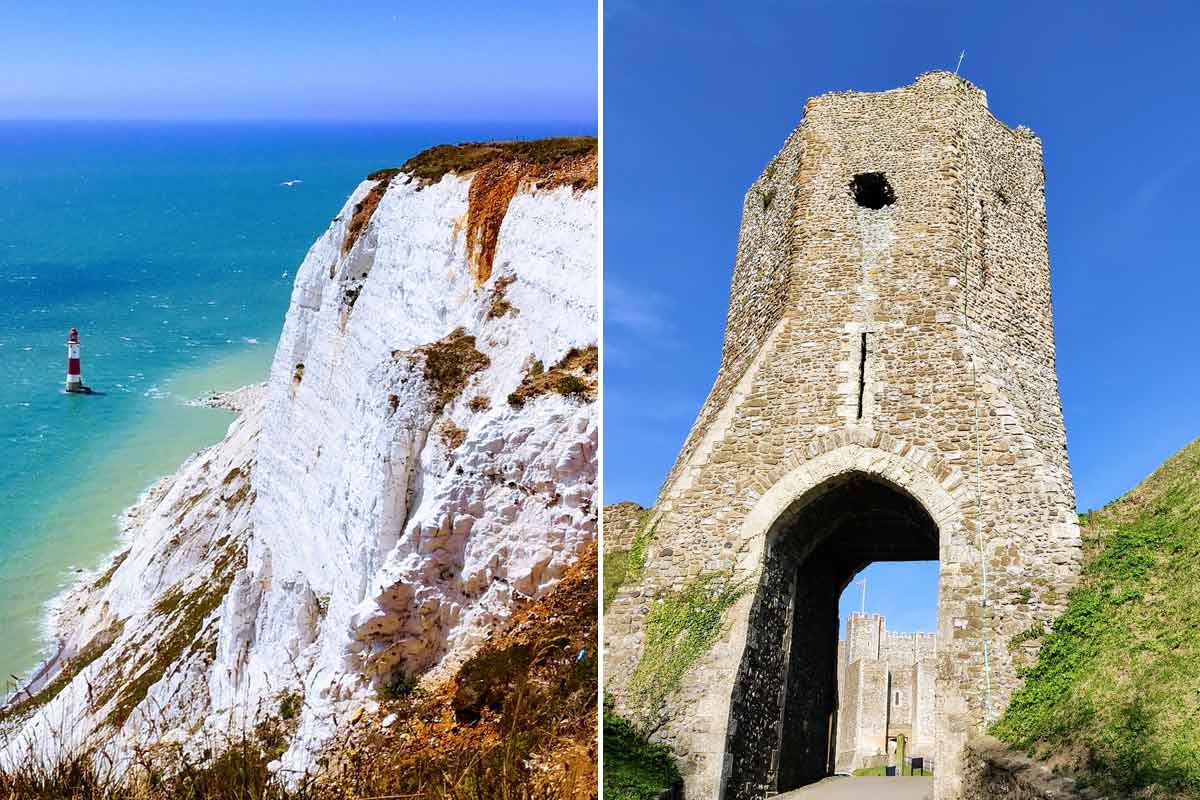
A day trip to the White Cliffs of Dover and Dover Castle from London presents an exceptional blend of Britain’s natural splendour and historical depth. These quintessentially British landmarks on the southeast coast offer visitors dramatic landscapes and a rich narrative of the nation’s history.
Main Attractions
White Cliffs of Dover
- Scenic Walks: The cliffs provide a variety of walking trails with breath-taking views across the English Channel and, on clear days, towards France.
- Visitor Centre: An ideal starting point, offering insights into the geology, flora, and fauna of the cliffs.
Why Visit: The White Cliffs of Dover are an enduring symbol of Britain’s defiance and independence, celebrated in poetry and song. Their sheer natural beauty and the panoramic vistas they afford are unparalleled.
Dover
- Medieval Castle: Delve into the Great Tower to experience the life of the royal court under King Henry II.
- Wartime Tunnels: Explore the labyrinth of secret tunnels that were pivotal during the Second World War, including their role in the Dunkirk evacuation.
- Roman Lighthouse and Saxon Church: Discover one of Britain’s oldest lighthouses and a well-preserved Saxon church within the castle’s grounds.
Why Visit: Known as the “Key to England,” Dover Castle has a storied history spanning over 2,000 years, from Roman times through to the Cold War. It offers visitors a comprehensive journey through Britain’s multifaceted past.
Getting There
- By Train: Direct services from London St Pancras International to Dover Priory station take about 1 hour and 15 minutes. Dover Castle is then a brief bus journey or an uphill walk away.
- By Car: A drive from London to Dover via the M2 and A2 motorways takes roughly 2 hours, providing the convenience to visit both the cliffs and the castle at leisure.
Best Time to Visit
- Avoiding Crowds: Visiting early in the morning or late in the afternoon can help evade peak times, especially on weekends and during school holidays.
- Seasonal Beauty: The period from spring to autumn offers the most favourable weather for outdoor exploration. The cliffs are particularly stunning in spring when adorned with wildflowers.
Tours
- Full-day White Cliffs of Dover and Canterbury Cathedral Tour from London: Guided Group Tour. Approx. 11h.
- Canterbury Cathedral, Dover Castle & White Cliffs Guided Day Tour from London: Guided Group Tour. Approx. 10h 30min.
Leeds Castle, Cliffs of Dover and Canterbury Day Trip from London with Guided Cathedral Tour: Guided Group Tour. Approx. 10h.
Practical Tips
- Visit Planning: Dedicate sufficient time to fully explore both the castle and the cliffs, as each site is rich in sights and stories.
- Appropriate Attire: The weather can be unpredictable, so dress in layers and wear comfortable walking shoes, especially if you plan to explore the cliff paths.
- Opening Times: Check the latest opening hours for Dover Castle and the Visitor Centre in advance to organise your day efficiently.
Nearby Attractions
- South Foreland Lighthouse: This historic Victorian lighthouse, accessible via a short walk from the cliffs, offers guided tours and exceptional views.
- Dover Museum: Further explore the local history, from ancient artefacts to contemporary tales, with a visit to the Dover Museum in the town centre.
A trip to the White Cliffs of Dover and Dover Castle offers a profound exploration of Britain’s natural wonders and historical legacy. From the cliff-top vistas across the channel to the historical depths of one of England’s most significant fortresses, this journey connects visitors with the enduring heart and soul of British heritage.
Unique Attractions & Experiences
Stonehenge
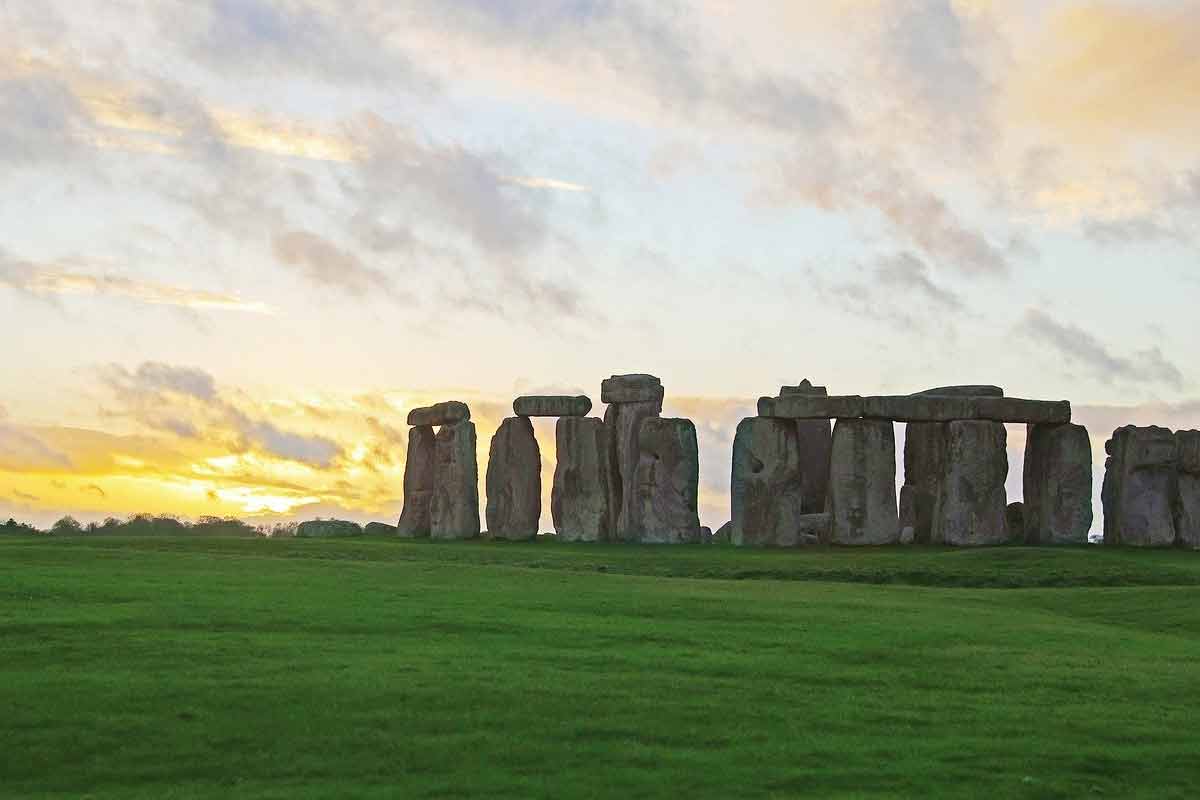
Stonehenge, one of the world’s most iconic prehistoric monuments, stands majestically on the Salisbury Plain in Wiltshire, England. This UNESCO World Heritage Site, dating back to around 2500 BC, captivates visitors with its ancient stones and enigmatic origins.
Main Attractions
- The Stone Circle: The centrepiece of the site, the standing stones, arranged in a precise circular setting, have intrigued people for millennia with their exact alignments and construction techniques.
- Visitor Centre: Features a comprehensive exhibition with hundreds of prehistoric artefacts and interactive displays that delve into Stonehenge’s history.
- Neolithic Houses: Reconstructions that provide insight into the lives of Stonehenge’s builders, showcasing the tools they used and their daily life.
Why Visit
Stonehenge presents a direct connection to Britain’s prehistoric times, offering a tangible link to the ancients who constructed this architectural wonder. The mystery of its purpose – be it a sacred burial ground, an astronomical clock, or something entirely different – enhances its fascination
Getting There
- By Train: Salisbury is the nearest railway station, about 15 kilometres from Stonehenge. Direct trains from London Waterloo to Salisbury take around 1.5 hours.
- By Car: A drive from London via the A303 leads directly to Stonehenge, with the journey lasting approximately 2 hours, traffic permitting.
- Tour Buses: Several companies operate day tours from London, often incorporating other attractions such as Bath or Windsor.
Best Time to Visit
- Early Morning or Late Afternoon: Visiting outside peak hours allows for a more tranquil experience.
- Summer and Winter Solstice: These periods draw large crowds for celebrations, marking the sunrise alignment with the stones.
Tickets and Tours
- Stonehenge Half- Day Tour from London with Admission: Guided Group Tour. Approx. 6h.
- Stonehenge, Windsor Castle, and Bath from London: Guided Group Tour. Approx. 11h.
- Stonehenge, Windsor Castle and Bath with Pub Lunch in Lacock: Guided Group Tour. Approx. 12h 30min.
- Windsor Castle, Stonehenge & Salisbury Cathedral: Guided Group Tour. Approx. 10h.
Practical Tips
- Advance Booking: Entry is timed ticketed, and booking ahead is strongly recommended to ensure access at your desired time.
- Weather Preparedness: The site is open to the elements; dressing in layers and being ready for all weather conditions is advised.
- Audio Guide: Renting an audio guide or downloading the Stonehenge app can enrich your visit with detailed commentary.
Nearby Attractions
- Salisbury: Explore the nearby city with its magnificent cathedral, which has the tallest spire in England.
- Avebury: Another significant Neolithic henge, larger than Stonehenge and offering a more intimate experience.
Visiting Stonehenge is an unforgettable journey into the heart of ancient Britain, connecting visitors with the mysteries and remarkable achievements of our ancestors. Whether you’re drawn by historical interest, spiritual significance, or simple curiosity, Stonehenge stands as a monument to human ingenuity and endurance. For more information, visit our dedicated Stonehenge page, Getting from London to Stonehenge travel page and Stonehenge Tours page.
Harry Potter Warner Bros. Studio Tour
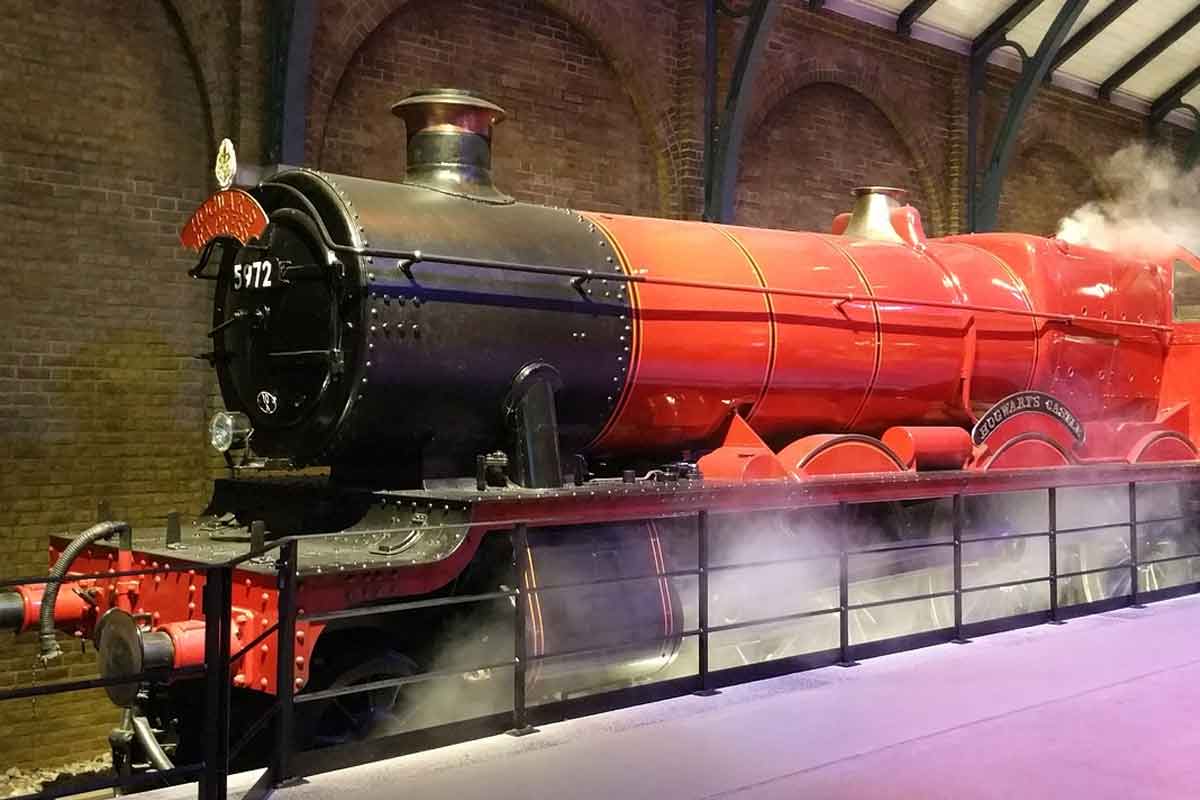
The Harry Potter Warner Bros. Studio Tour in Leavesden, near London, offers an enchanting journey into the world of filmmaking, specifically the making of the Harry Potter film series. This behind-the-scenes tour provides fans with the opportunity to explore the magic that brought J.K. Rowling’s beloved books to life on the big screen.
Main Attractions
- Sets: Walk through iconic sets, including the Great Hall, Diagon Alley, and the Forbidden Forest, meticulously preserved as they were during filming.
- Props and Costumes: See the incredible detail in the costumes, props, and creatures used in the films, from Harry’s Nimbus 2000 to the intricate Horcruxes.
- Special Effects: Discover the secrets behind the series’ spellbinding special effects, from green screen techniques to animatronics.
Why Visit
For Harry Potter fans, the studio tour is a must-visit destination that offers an immersive experience into the cinematic universe of Harry Potter. It’s a unique chance to step into the films’ sets, understand the craftsmanship behind the scenes, and relive the magic of the story.
Getting There
- By Train: The nearest railway station is Watford Junction, from which a shuttle bus runs to the studio. Trains to Watford Junction depart regularly from London Euston, with a journey time of approximately 20 minutes.
- By Car: Located just off the M25 and M1 motorways, the studio is easily accessible by car. Parking is available on site.
Best Time to Visit
- Booking in Advance: Tickets must be purchased in advance and have specific entry times. Booking early is essential, especially during peak times like school holidays and weekends.
- Seasonal Events: The studio tour hosts special events throughout the year, such as “Hogwarts in the Snow” during the winter months and “Dark Arts” for Halloween, offering unique experiences depending on the season.
Tickets and Tours
- Harry Potter Tour of Warner Bros. Studio with Luxury Transport from London: Transport from London & admission ticket. Approx. 7h.
- Fully Guided Tour of Warner Bros Studio Tour London – The Making of Harry Potter: Guided Group Tour. Approx. 6h.
- Warner Bros. Studio Tour London – The Making of Harry Potter and Oxford Day Trip: Partially Guided (Oxford) Group Tour. Approx. 10h 30min.
Practical Tips
- Duration of Visit: Allocate at least half a day for the tour, as there is much to see and explore. Some visitors may wish to spend a full day to fully appreciate all the details.
- Facilities: The studio offers a range of facilities, including a café and a gift shop where you can purchase exclusive Harry Potter merchandise.
- Accessibility: The tour is accessible to visitors with disabilities, with wheelchairs available and most areas equipped for accessibility.
The Harry Potter Warner Bros. Studio Tour not only celebrates the success of one of the most beloved film series but also offers an insightful look into the art of filmmaking. It’s a magical experience that captivates fans of all ages, leaving them with lasting memories of the wizarding world.
Downton Abbey Filming Locations
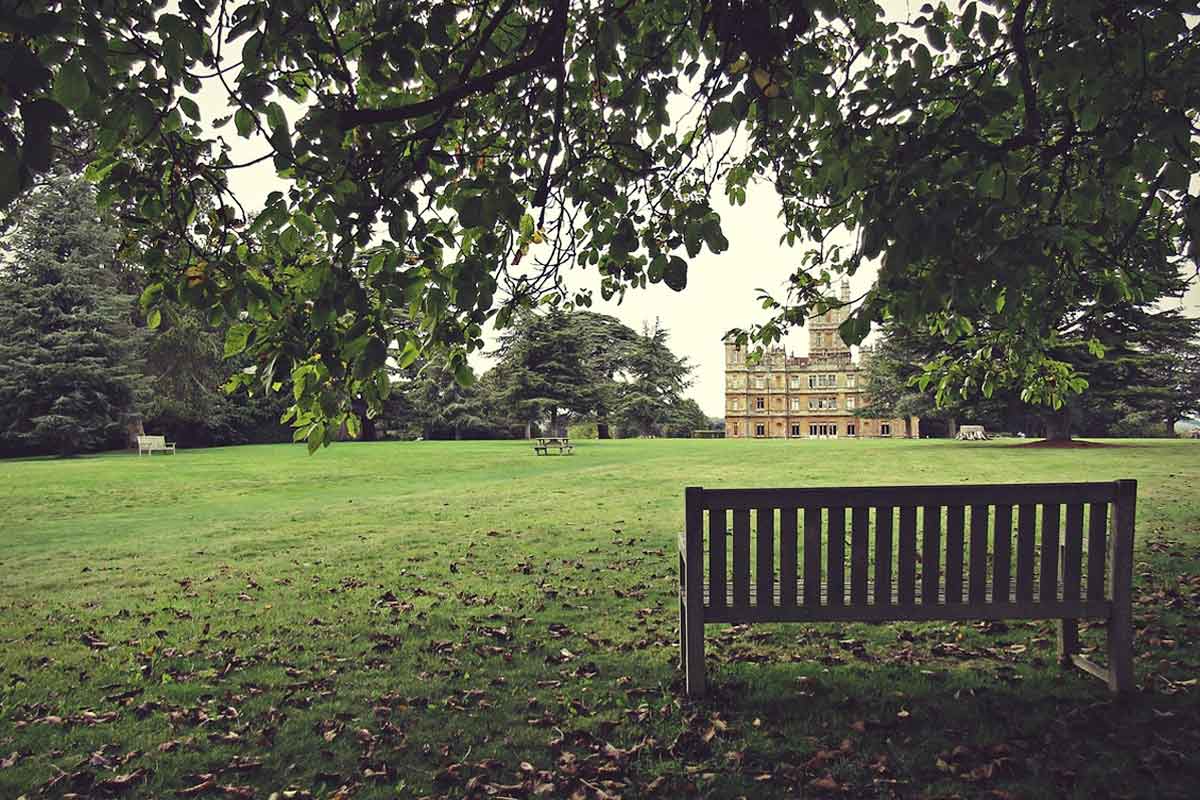
Delve into the world of the beloved television series “Downton Abbey” with a visit to its iconic filming locations. Just a short journey from London, these sites offer fans a chance to step into the Edwardian era and relive the drama, romance, and elegance of the Crawley family’s story.
Higclere Castle
- Main Attraction: The majestic Highclere Castle, located in Hampshire, serves as the primary setting for Downton Abbey, representing the fictional Downton estate.
- Why Visit: Wander through the grand reception rooms, explore the beautiful gardens, and discover the rich history of the castle, which is a remarkable piece of Victorian architecture in its own right.
- Getting There: Highclere Castle is accessible by train from London Paddington to Newbury, followed by a short taxi ride. By car, it’s about a 1.5-hour drive from London.
Bampton Village
- Main Attraction: The charming village of Bampton in Oxfordshire doubled as Downton village, hosting several key locations, including the exterior shots of Downton hospital, the Crawley family home, and St. Mary’s Church.
- Why Visit: Stroll through the village to see the familiar facades used in the series and feel the quaint atmosphere that represents the essence of rural England.
- Getting There: Bampton is best reached by car from London in approximately 1.5 hours. Public transport options involve trains to Oxford and then a bus or taxi to Bampton.
Cogges Manor Farm
- Main Attraction: Located near Witney in Oxfordshire, Cogges Manor Farm was transformed into Yew Tree Farm for the series, where many of the farming scenes were filmed.
- Why Visit: Experience the rustic charm of the farm, which is now an interactive museum showcasing rural life, and explore the setting of many of Downton Abbey’s memorable moments.
- Getting There: The farm is a short drive from Bampton or a train journey to Witney from London, followed by a bus or taxi.
Tips for Visiting
- Book in Advance: Many of these locations are private estates or functioning farms that open to the public on specific dates. Check their websites and book your visit in advance.
- Plan Your Day: If you’re planning to visit multiple locations, start early and consider the opening times and distance between sites.
- Guided Tours: Look for guided tours that specialize in Downton Abbey locations, offering a streamlined way to see the sites and gain insights into the filming of the series.
Tours
- Downton Abbey and Oxford Tour from London Including Highclere Castle: Guided Group Tour by Coach. Approx. 10h
- Downton Abbey Village, Blenheim Palace and Cotswolds Day Trip from London: Guided Group Tour by Coach. Approx. 10h
- ‘Downton Abbey’ TV Locations and Blenheim Palace Tour from London: Guided Group Tour by Coach. Approx. 10h
Visiting the filming locations of Downton Abbey offers a unique opportunity to immerse yourself in the world of the series, experiencing the beauty and history of the English countryside that brought the show to life. Whether you’re a die-hard fan or simply appreciate the architectural and natural beauty of these sites, a day trip to these locations promises a memorable journey back in time.
Lacock
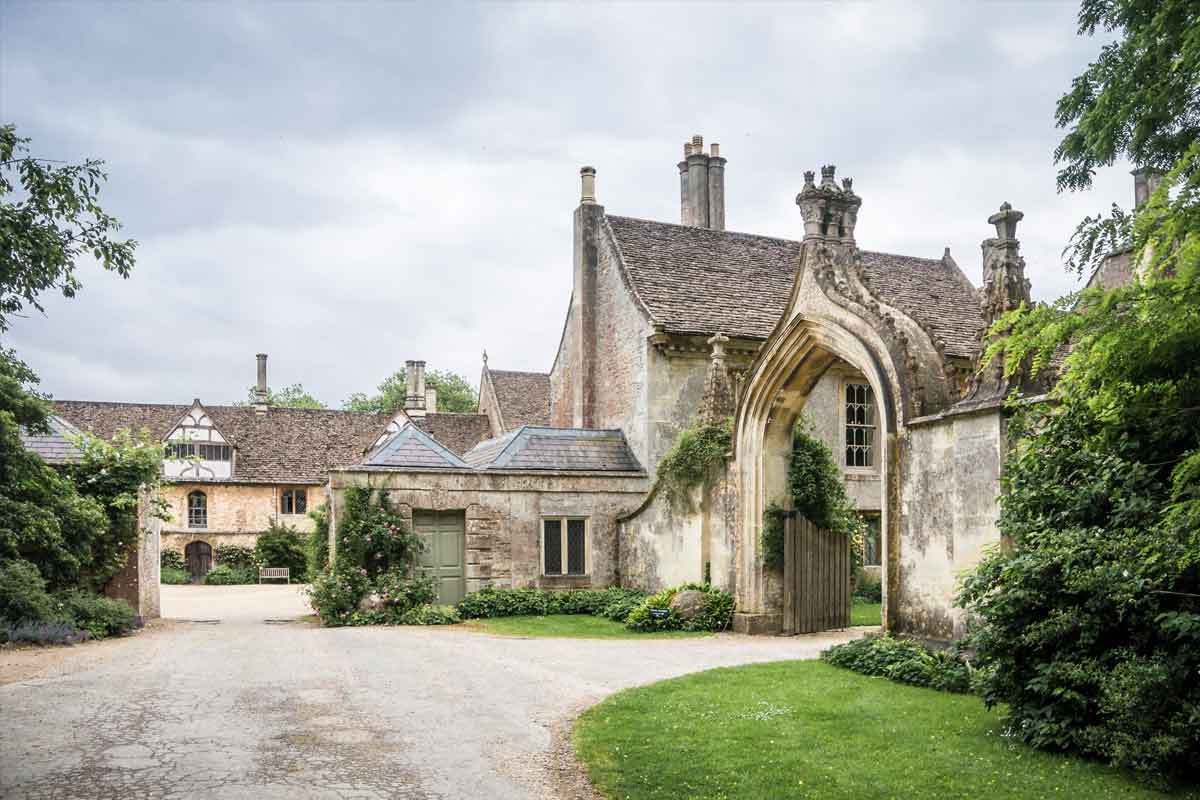
Nestled in the heart of Wiltshire, England, the picturesque village of Lacock is a step back in time. With its well-preserved medieval streets, historic abbey, and traditional stone houses, Lacock has become a favourite for film and television producers, most notably as a filming location for the Harry Potter series and other period dramas.
Main Attractions
- Lacock Abbey: Founded in the 13th century, the abbey’s stunning architecture and cloistered courtyards served as the interiors of Hogwarts in several Harry Potter films. Its grounds and gardens offer peaceful walks.
- The Village: Lacock village, largely owned by the National Trust, retains its historic charm with no modern signage or electrical wires visible. It’s like walking through a living museum.
- Fox Talbot Museum: Located within Lacock Abbey, this museum is dedicated to William Henry Fox Talbot, a pioneer of photography. It explores the history of photography and Talbot’s contributions to its development.
Why Visit
Lacock provides a unique blend of historical, cultural, and cinematic appeal. Fans of Harry Potter will delight in exploring locations used in the films, while history enthusiasts can appreciate the preserved medieval architecture and the significance of Fox Talbot’s work in photography.
Getting There
- By Train: The nearest train station to Lacock is Chippenham, with regular services from London Paddington. From Chippenham, Lacock is a short taxi or bus ride away.
- By Car: Driving from London to Lacock takes approximately 2 hours, offering a scenic route through the English countryside.
Best Time to Visit
- Spring and Summer: These seasons showcase Lacock at its most beautiful, with blooming gardens and longer daylight hours for exploring. However, it’s worth visiting any time of year for its timeless appeal.
- Special Events: Look out for medieval fairs, Christmas markets, and photography exhibitions at Lacock Abbey, which add extra charm to the village.
Tours
Lacock and Castle Combe – Afternoon Private Tour: Approx. 5 hours
Bath, Avebury and Lacock Village Small-Group Day Tour from London: Approx. 10h.
Stonehenge, Windsor Castle and Bath with Pub Lunch in Lacock: Guided Group Tour. Approx. 12h 30min.
Practical Tips
- Plan Ahead: Check opening times for Lacock Abbey and the Fox Talbot Museum, as they can vary seasonally.
- Stay Respectful: Remember that Lacock is a living village with local residents. Be mindful and respectful while exploring and taking photographs.
- Explore the Surroundings: The Wiltshire countryside around Lacock offers additional attractions, including beautiful walks and traditional English pubs for a meal or a drink.
A visit to Lacock is an enchanting experience, offering a glimpse into England’s past, the magic of the movies, and the dawn of photography. Whether you’re exploring the historic abbey, wandering the untouched streets of the village, or delving into the origins of photography, Lacock promises a memorable day out from London.
Unique Attractions & Experiences
Hampton Court Palace
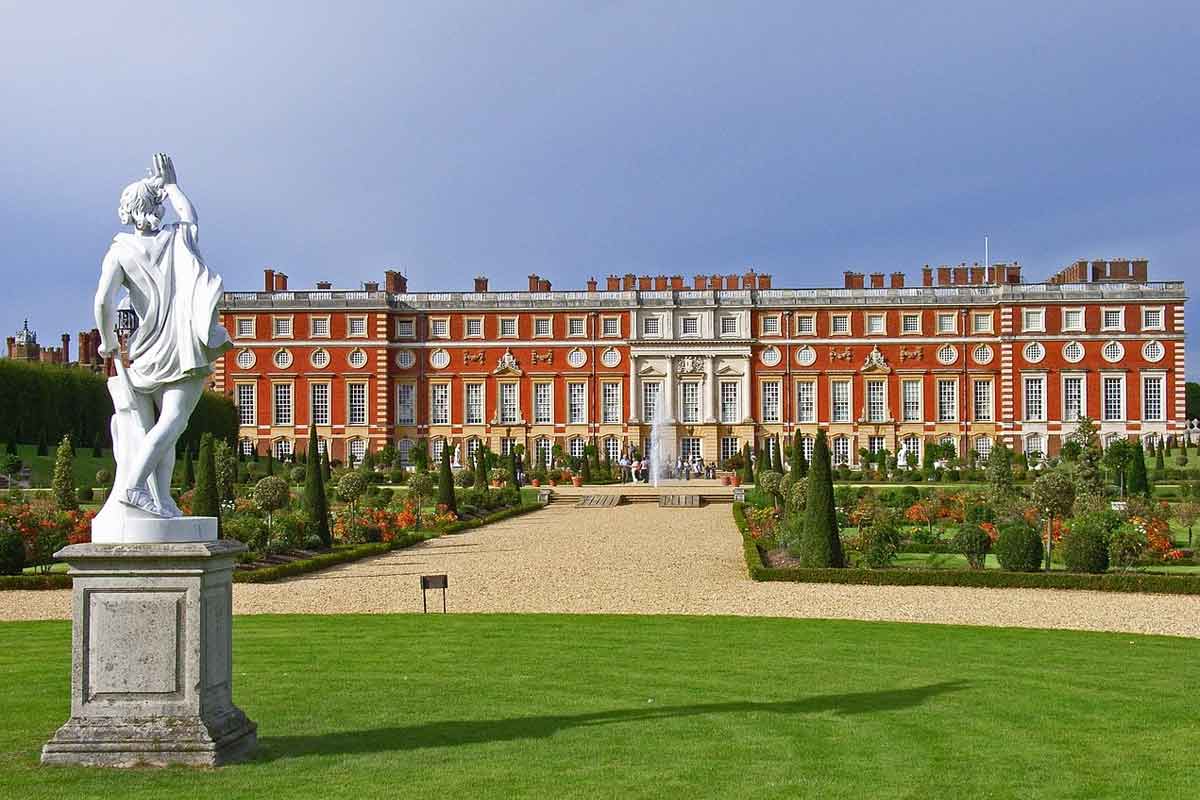
Hampton Court Palace, located in the London Borough of Richmond upon Thames, stands as a testament to Tudor grandeur and baroque opulence. Once the home of King Henry VIII, this majestic palace offers visitors a fascinating glimpse into England’s royal history, set against the backdrop of stunning gardens and the famous maze.
Main Attractions
- The State Apartments: Explore the lavish Tudor State Apartments, including Henry VIII’s Great Hall, one of England’s most magnificent medieval halls, adorned with tapestries and stained glass.
- The Gardens: Spanning 60 acres, the palace’s gardens include the famous Maze, the Great Vine, and the beautifully restored baroque gardens designed by William III and Mary II.
- The Chapel Royal: Attend a service or simply visit to admire the splendid interior of this active royal chapel, which has been in continuous use for over 450 years.
- The Tudor Kitchens: Discover the scale and complexity of the Tudor kitchens, where banquets were prepared for Henry VIII and his court.
Why Visit
Hampton Court Palace is a unique blend of architectural styles, reflecting its use by monarchs over the centuries. It offers a comprehensive royal experience, from the intrigue of the Tudor period to the elegance of the baroque. The palace’s interactive exhibits, costumed guides, and beautifully maintained gardens make it an educational and enjoyable day out for all ages.
Getting There
- By Train: Direct trains from London Waterloo to Hampton Court station take approximately 35 minutes, followed by a short walk to the palace over the bridge across Thames River.
- By Car: Hampton Court Palace is easily accessible by car, located about 12 miles southwest of central London, with parking available on-site.
Best Time to Visit
- Spring and Summer: The gardens are particularly stunning during these seasons, with flowers in bloom and the palace hosting various outdoor events and festivals.
- Special Events: Look out for the annual Hampton Court Palace Flower Show, ghost tours around Halloween, and the festive ice skating rink in winter.
Tours
Private tour of Hampton Court Palace with a qualified tour guide: Approx. 2h 30min.
Windsor Castle and Hampton Court Palace Tour: Guided Group Tour. Approx. 10h.
Practical Tips for Visiting
- Purchase Tickets in Advance: To save time and possibly money, buy your tickets online before visiting.
- Audio Guide: Make use of the complimentary audio guide to enrich your visit with historical context and stories about the palace’s past inhabitants.
- Plan Your Day: There’s a lot to see, so consider arriving early to make the most of your visit. Don’t miss the live historical reenactments and demonstrations that occur throughout the day.
- Dress Appropriately: Be prepared for a lot of walking, especially if you plan to explore the extensive gardens, and check the weather forecast in advance.
A visit to Hampton Court Palace is more than just a step back in time; it’s an immersive journey into the lives of the monarchs who lived, loved, and entertained within its walls. With its rich history, stunning architecture, and beautiful gardens, Hampton Court Palace remains one of the most enchanting royal palaces in England.
Blenheim Palace
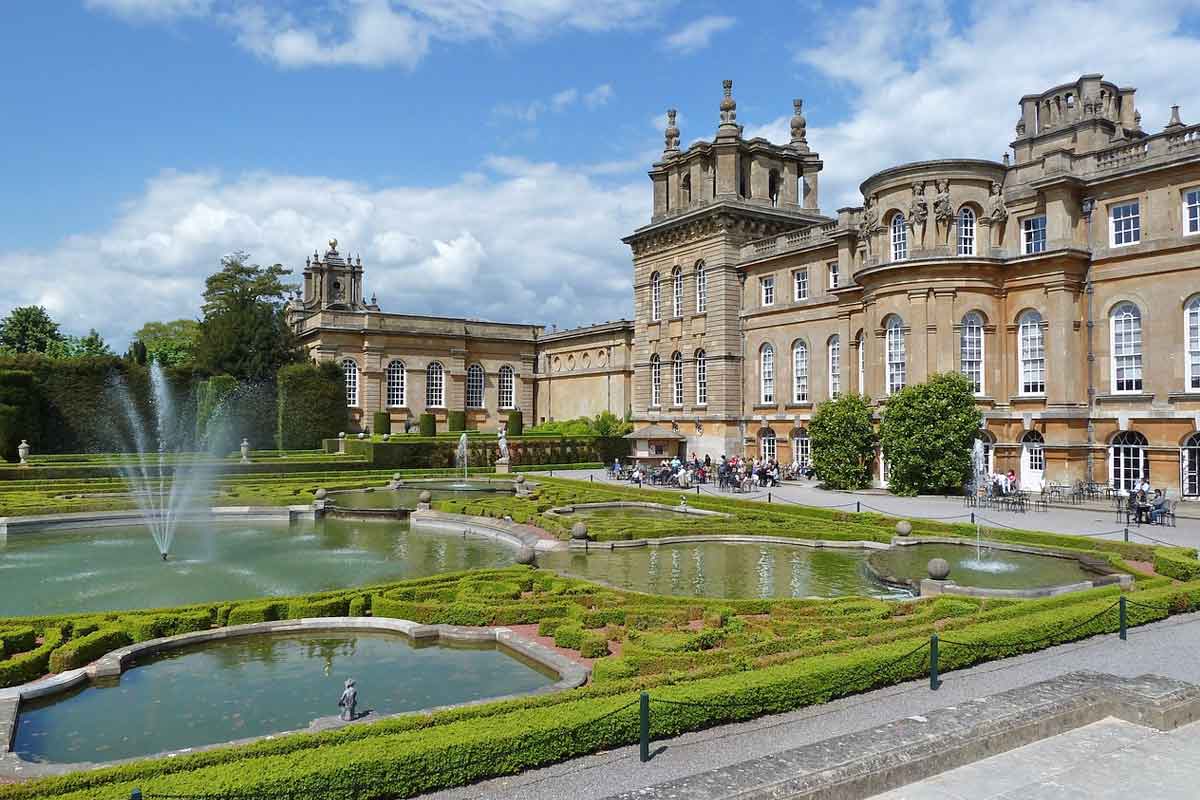
Blenheim Palace, a UNESCO World Heritage Site located in Woodstock, Oxfordshire, is a monumental country house and the principal residence of the Dukes of Marlborough. Celebrated as the birthplace of Sir Winston Churchill, this baroque masterpiece is set within over 2,000 acres of exquisite parkland and formal gardens, offering a splendid example of 18th-century architecture.
Main Attractions
- The State Rooms: Explore the opulent State Rooms, adorned with exquisite tapestries, paintings, and furnishings, each telling part of the palace’s and the Marlborough family’s history.
- The Park and Gardens: Designed by the famous landscape architect Capability Brown, the palace grounds feature the Formal Gardens, including the Water Terraces, the Secret Garden, and the Rose Garden, as well as the vast parkland with its natural beauty.
- The Churchill Exhibition: Discover the life and legacy of Sir Winston Churchill in the exhibition located in the room where he was born, showcasing personal memorabilia and photographs.
- The Pleasure Gardens: A delight for families, offering a giant maze, a butterfly house, and an adventure playground, making it an enjoyable day out for visitors of all ages.
Why Visit
Blenheim Palace not only stands as a monument to British heritage and the achievements of one of its most notable families but also offers visitors an insight into the life of one of Britain’s greatest leaders. The palace and its grounds provide a rich cultural experience, from the grandeur of its architecture and interiors to the tranquility and natural beauty of its gardens and parkland.
Getting There
- By Train: The nearest train station is Oxford, from which you can take a bus or taxi to Blenheim Palace. The journey from London Paddington to Oxford takes approximately an hour.
- By Car: Located about 8 miles northwest of Oxford, Blenheim Palace is easily accessible by car via the A44, with the journey from London taking around 1.5 hours. Parking is available on-site.
Best Time to Visit
- Spring and Summer: The gardens are in full bloom, and the estate hosts numerous outdoor events, including flower shows and equestrian competitions.
- Autumn: Offers a spectacular display of fall colours in the parkland, making it a perfect time for picturesque walks.
- Christmas: The palace and its grounds are transformed with festive decorations, a Christmas market, and themed events, offering a magical holiday experience.
Tours
- The Cotswolds and Blenheim Palace: Guided Group Tour by Coach. Approx. 10h
- Downton Abbey Village, Blenheim Palace and Cotswolds Day Trip from London: Guided Group Tour by Coach. Approx. 10h
- ‘Downton Abbey’ TV Locations and Blenheim Palace Tour from London: Guided Group Tour by Coach. Approx. 10h
Practical Tips for Visiting
- Purchase Tickets in Advance: To ensure entry and potentially save on admission, it’s advisable to buy your tickets online before your visit.
- Wear Comfortable Shoes: With extensive grounds to explore, comfortable footwear is a must.
- Allow Plenty of Time: To fully appreciate all that Blenheim Palace has to offer, plan to spend the majority of the day exploring both the interiors and the extensive grounds.
- Check for Events: The palace’s calendar is filled with a variety of events throughout the year. Check ahead of your visit to see if your trip coincides with any special events that might enhance your experience.
Blenheim Palace offers a unique blend of historical grandeur, architectural beauty, and natural splendour, making it an essential visit for those interested in Britain’s cultural heritage, the aristocracy’s history, and the legacy of Sir Winston Churchill.
Warwick Castle
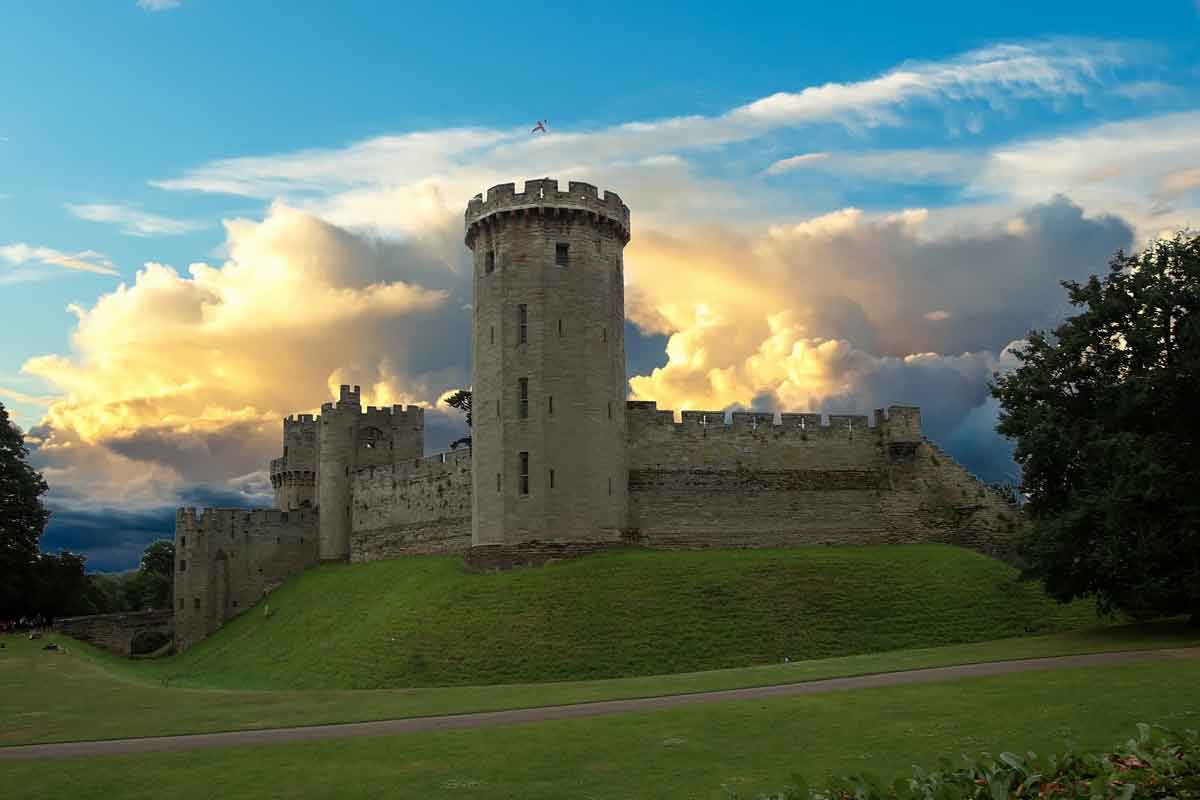
Warwick Castle presents an immersive historical experience, from the grandeur of its staterooms to the excitement of its jousting knights and interactive attractions. It’s a place where history is brought to life through live shows, dramatic reenactments, and hands-on exhibits, making it an ideal destination for families, history buffs, and adventure seekers.
Main Attractions
- The Castle’s Towers and Ramparts: Explore the medieval towers and ramparts for breath-taking views of the Warwickshire countryside and insights into the life of a medieval soldier.
- The Great Hall and State Rooms: Step inside the castle’s grand interior spaces, beautifully furnished to reflect their historic significance, showcasing a mix of medieval artifacts and Victorian opulence.
- The Castle Dungeon: Experience the darker side of Warwick Castle’s history with a visit to the dungeon, featuring live actors and special effects that bring gruesome historical events to life.
- The Falconer’s Quest: Watch the UK’s largest birds of prey show, demonstrating the art of falconry in a spectacular setting by the river.
Why Visit
Warwick Castle presents an immersive historical experience, from the grandeur of its staterooms to the excitement of its jousting knights and interactive attractions. It’s a place where history is brought to life through live shows, dramatic reenactments, and hands-on exhibits, making it an ideal destination for families, history buffs, and adventure seekers.
Travel Information
- By Train: Warwick Station is the nearest railway station, with regular services from London Marylebone and Birmingham. The castle is a short walk from the station.
- By Car: Located just off the M40, Warwick Castle is easily accessible by car and offers parking on-site. The journey from London takes approximately 1.5 to 2 hours.
Best Time to Visit
- Summer: The warmer months are perfect for enjoying the castle’s outdoor shows and lush gardens. However, this is also peak tourist season, so be prepared for larger crowds.
- Special Events: Warwick Castle hosts a variety of seasonal events, including Halloween festivities in October and a magical Christmas market during the holiday season. These events offer unique reasons to visit outside the summer months.
Tickets and Tours
- Oxford, Stratford-upon-Avon and Warwick Castle Day Trip from London: Group tour. Approx. 10h 30min.
- Oxford, Stratford, Cotswolds & Warwick Castle Tour from London: Group tour. Approx 10h 30min.
- Warwick Castle Including Return Train Tickets from London
- Warwick Castle Admission Ticket
Practical Tips
- Book in Advance: Purchasing tickets online in advance can save money and time on the day of your visit.
- Plan Your Day: Check the schedule of events and shows upon arrival to make the most of your visit. Some attractions have specific start times, so planning ahead can help you see everything you’re interested in.
- Wear Comfortable Shoes: The castle grounds cover a large area with some uneven surfaces, so comfortable footwear is essential.
- Explore the Grounds: Beyond the main castle, the gardens, and the Peacock Garden are worth exploring for a quieter moment away from the main attractions.
Warwick Castle offers a unique blend of historical exploration and entertainment, set within one of England’s most iconic medieval fortresses. Whether you’re delving into the depths of the dungeons, marvelling at the majesty of the Great Hall, or enjoying the thrill of the joust, Warwick Castle promises an unforgettable journey through time.
Unique Attractions & Experiences
Rye & Hastings
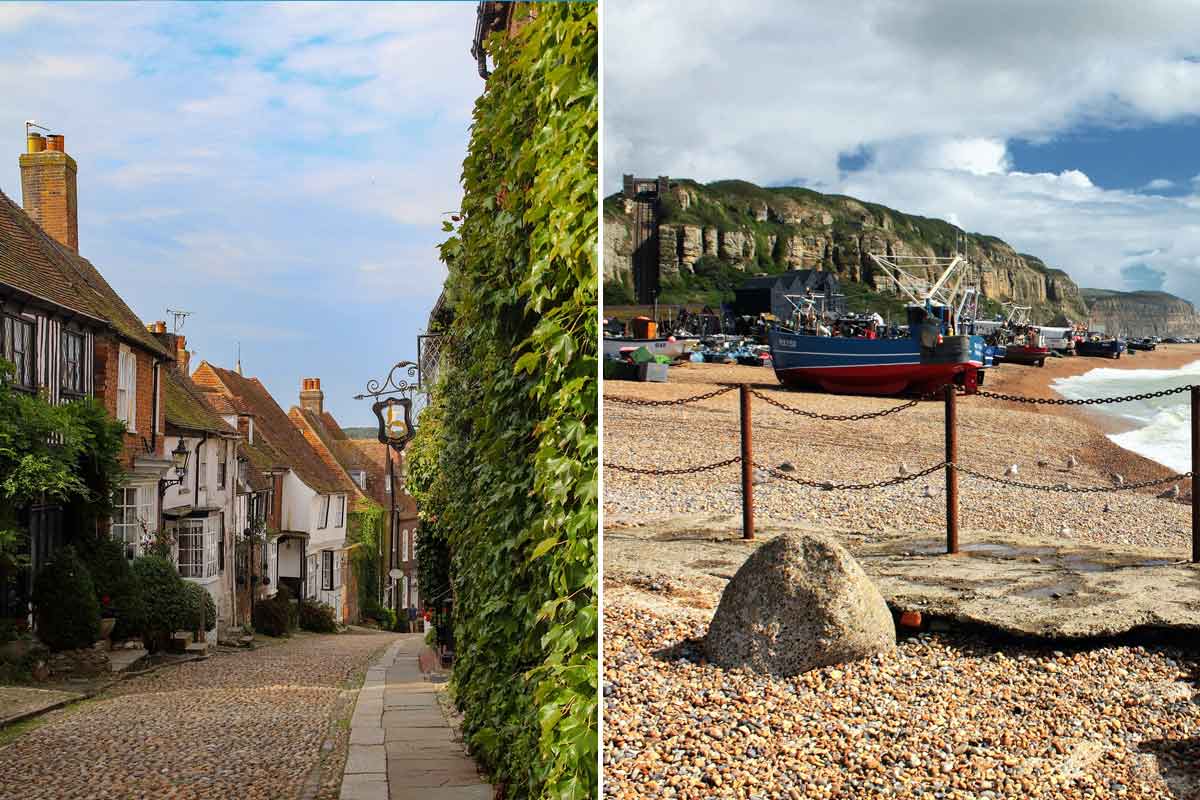
Rye and Hastings, located in East Sussex on the south coast of England, offer a captivating blend of historical intrigue and natural beauty. These neighbouring towns are steeped in history, from medieval battles to smuggling tales, set against the backdrop of stunning coastal landscapes.
Main Attractions
Rye
- Mermaid Street: Famous for its cobbled streets and historic buildings, Mermaid Street is quintessentially English and home to the legendary Mermaid Inn, known for its associations with smugglers.
- Rye Castle Museum: Also known as Ypres Tower, this 13th-century fortification offers insights into Rye’s rich history, including its role in defence and as a prison.
- Rye Harbour Nature Reserve: A site of scientific interest, the reserve is a haven for wildlife enthusiasts, offering picturesque walks and bird-watching opportunities.
Hastings
- Hastings Castle: The ruins of the first castle in England built by William the Conqueror offer panoramic views of the town and sea.
- The Old Town: Hastings Old Town is a charming area with narrow streets, antique shops, and traditional fishermen’s huts. The Hastings Fishermen’s Museum tells the story of the town’s maritime history.
- Hastings Country Park: Spanning over 850 acres, the park offers stunning cliff-top walks with views across the English Channel and is a site of biodiversity.
Getting There
- By Train: Direct trains run from London to both Rye and Hastings, making them easily accessible for day trips. The journey takes approximately 1.5 to 2 hours.
- By Car: Driving from London takes around 2 hours, offering the flexibility to explore both towns and the surrounding countryside at your own pace.
Best Time to Visit
- Summer: The warmer months are ideal for enjoying the coastal scenery, nature reserves, and outdoor attractions. However, these months can also be the busiest.
- Off-Peak Seasons: Spring and autumn provide a quieter experience, with the added beauty of seasonal changes in the landscapes.
Practical Tips for Visiting
- Plan Your Journey: If visiting both towns in one day, start early to make the most of your time. Rye and Hastings are about a 30-minute drive apart.
- Wear Comfortable Shoes: Both towns are best explored on foot, with many cobbled streets and nature walks.
- Check Local Events: Rye and Hastings host various festivals and events throughout the year, from seafood fairs to pirate day celebrations, adding a unique flavour to your visit.
Rye and Hastings offer a rich tapestry of England’s history, from the charm of ancient streets to the wild beauty of the coast. Whether you’re exploring ancient ruins, enjoying the local culinary scene, or taking in the natural landscapes, these towns promise a memorable escape from the hustle and bustle of city life.
A Scenic Beach Close to Rye: Camber Sands
Camber Sands is known for its long stretch of golden sandy beach and is situated just a few miles south of Rye on the East Sussex coast. It’s a popular destination for beachgoers and is known for its dunes and scenic views.
Liverpool & The Beatles
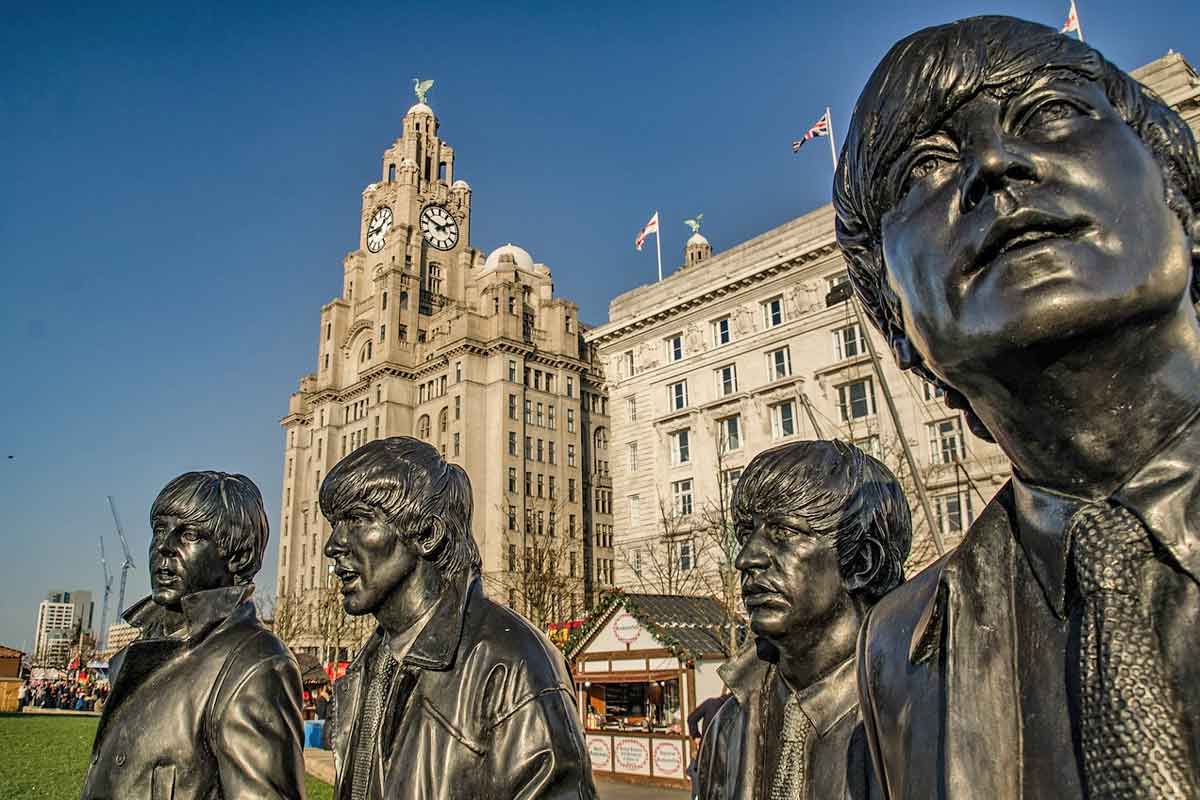
Liverpool, a vibrant city in the North West of England, is synonymous with The Beatles, one of the most famous and influential bands in the history of music. This UNESCO World Heritage city not only boasts significant cultural and historical landmarks but also offers an immersive Beatles experience for fans and music lovers alike.
Main Attractions
- The Beatles Story: Located at the Albert Dock, this award-winning museum offers an in-depth journey through the lives, times, and music of The Beatles, featuring replicas of key locations from their career, including The Cavern Club.
- Cavern Club: The legendary venue where The Beatles played in their early days. Today, it continues to host live music and is a pilgrimage site for fans.
- Magical Mystery Tour: This guided bus tour takes visitors around key Beatles landmarks in Liverpool, including Penny Lane, Strawberry Field, and the childhood homes of John Lennon and Paul McCartney.
- Strawberry Field: The site that inspired one of The Beatles’ most famous songs, now home to an exhibition exploring the song’s history and John Lennon’s early life, with a café and gardens open to the public.
Why Visit
Liverpool offers a unique opportunity to explore the roots of The Beatles’ phenomenon and experience the city that shaped their music and personalities. From iconic venues to intimate exhibitions, Liverpool celebrates the legacy of its most famous sons in a way that’s engaging for both die-hard fans and casual visitors.
Getting There
- By Train: Liverpool is well-connected by train to major cities in the UK, including direct services from London Euston to Liverpool Lime Street, with a journey time of around 2 hours.
- By Car: Driving from London to Liverpool takes approximately 4 to 5 hours, depending on traffic.
Best Time to Visit
- International Beatleweek: Held annually in August, this festival celebrates The Beatles with live music, exhibitions, and special events across the city, attracting fans from all over the world.
- Year-Round: Liverpool’s Beatles attractions are open year-round, offering a fascinating insight into the band’s history regardless of the season.
Tours and Tickets
- Beatles Magical Mystery Tour: Guided walking tour. Approx. 2h 30min
- Beatles Magical Mystery Tour: Bus tour with photo stops. Approx 2h.
- Skip the Line: Liverpool Beatles Museum Ticket
- The Beatles Story Experience Ticket
Practical Tips for Visiting
- Book in Advance: Popular attractions like The Beatles Story can get busy, especially during peak tourist seasons and special events. Booking tickets in advance is recommended.
- Wear Comfortable Shoes: Much of Liverpool’s Beatles-related history can be explored on foot, including walking tours around significant landmarks.
- Explore Beyond The Beatles: Liverpool’s rich cultural scene, historic docks, and vibrant nightlife offer plenty to experience beyond The Beatles, making it worth extending your visit.
Liverpool’s indelible link with The Beatles not only marks it as a must-visit destination for music fans but also showcases the city’s broader cultural and historical significance.
Exploring Liverpool through the lens of The Beatles’ legacy allows visitors to experience the city’s transformative impact on the world of music while enjoying the warmth and hospitality that Liverpool is known for.
Did You Know?
The signature on the Penny Lane street sign in Liverpool actually belongs to Paul McCartney himself. Curious readers can delve into this fascinating tidbit by watching the related episode of Carpool Karaoke with James Corden.
Tips for Day Trips from London
Utilise London’s Transport Hubs Efficiently
- Strategically Choose Your Departure Station: London has several major train stations, each serving different regions of the UK. Plan your trip based on the most direct route from the station closest to your location or accommodation. For instance, to visit Cambridge, King’s Cross is your best starting point, while Paddington is ideal for trips to Windsor.
Leverage Less-Known Travel Discounts
- Two-for-One Offers: Look for 2-for-1 entry deals on attractions when you travel by train. You’ll need to present a valid train ticket and a downloaded voucher from the Days Out Guide website.
- Group Save Tickets: If travelling in a group of 3 to 9 people, you can save on train fares with GroupSave, available on off-peak journeys with participating train companies.
Optimise Your Sightseeing with Technology
- Audio Guides and Apps: Enhance your visit with downloadable audio guides or apps specific to the destination. Many historic sites and museums offer their own, providing a rich, self-paced tour without the need for a live guide.
- Digital Maps for Efficient Route Planning: Beyond just plotting points, use apps like Google Maps to check real-time traffic for car journeys or walking times between sites in walkable cities like Oxford and Bath.
Make Restaurant Reservations in Advance
- Popular Dining Spots: For destinations known for their culinary offerings, like Brighton or Bath, book restaurants ahead of time, especially for weekend visits. This ensures you won’t miss out on top-rated dining experiences due to last-minute availability issues.
Check for Local Events and Closures
- Local Festivals and Events: Some destinations have specific times of the year when they host festivals or events, which can be a draw or a deterrent, depending on your interest. For instance, visiting Stratford-upon-Avon during Shakespeare’s birthday celebrations offers unique experiences not available at other times.
Smart Packing for the British Weather
- Prepare for All Conditions: Even if the forecast looks clear, always pack a compact umbrella or a lightweight raincoat. Weather can change quickly, especially in coastal areas like the Seven Sisters or rural areas like the Cotswolds.
Early Bird or Night Owl? Plan According to Your Interests
- Sunrise and Sunset Times: For photography enthusiasts or those wanting to enjoy landscapes in the best light, check the sunrise and sunset times. Early morning visits to places like Stonehenge or the White Cliffs of Dover offer spectacular views with fewer people.
Take Advantage of Local Knowledge
- Visitor Centres and Local Insights: Upon arrival, visit the local tourist information or visitor centre for the latest advice, recommendations, and sometimes even discounts on attractions and dining. They can offer insights not always found online.
Map of Day Trips from London
Frequently Asked Questions
Frequently asked questions about day trips from London
What are the best day trips out of London with kids?
London offers several family-friendly day trip options. Consider visiting LEGOLAND Windsor, the Warner Bros. Harry Potter Studio Tour, or the magical world of Chessington World of Adventures.
Can I go to another European country for a day trip from London?
Yes, it’s possible to visit another European country for a day trip from London. You can take the Eurostar train to Paris, Brussels, or Amsterdam and return on the same day if you have the appropriate visa and plan accordingly.
I have a cruise departing from Southampton. What can I do before or after the cruise on the same day?
You can make the most of your cruise day by taking guided tours from Southampton. Explore attractions like Stonehenge, Salisbury Cathedral, or the historic city of Winchester before embarking on your cruise adventure.
I have a flight from London in the late afternoon. Where can I visit with my luggage?
There are day tours available that cater to travellers with late afternoon flights from London. Consider booking a tour to Stonehenge, Windsor Castle, or Bath, where you can explore these attractions and be conveniently dropped off at Heathrow Airport with your luggage.
Can I visit multiple day trip destinations in one day from London?
Yes, it’s possible to combine certain day trip destinations if they are in close proximity. For example, you can visit Windsor Castle and Stonehenge in one day, or explore Oxford and the Cotswolds together.
Are there day trips suitable for nature enthusiasts near London?
Absolutely! Nature lovers can enjoy day trips to places like the Seven Sisters chalk cliffs, the White Cliffs of Dover, or the scenic landscapes of the Cotswolds.
What are some unique day trips for history buffs in the London area?
History enthusiasts will appreciate day trips to historically significant sites like Dover Castle, Warwick Castle, and the Downton Abbey filming locations, which offer immersive historical experiences.
Can I find day trips from London that are budget-friendly?
Yes, there are budget-friendly day trips available. Consider exploring free attractions like the White Cliffs of Dover, walking tours in London, or using a London Pass for discounts on various attractions.
Are there day trips suitable for art and culture enthusiasts near London?
Art and culture enthusiasts can explore attractions like the Harry Potter Warner Bros. Studio Tour, the historic city of Bath with its Roman Baths, or the cultural richness of Stratford-upon-Avon, Shakespeare’s birthplace.
Can I take day trips from London during the Christmas season?
Yes, many day trip destinations offer festive experiences during the Christmas season. You can visit Christmas markets in Bath, enjoy the lights at Blenheim Palace, or explore the holiday magic in Oxford and Windsor.
Can I find tours for groups when planning day trips from London?
Yes, there are options for group tours when planning day trips from London. You can choose from pre-planned group tours that follow established routes to popular destinations. Additionally, many tour operators offer private tours, allowing you to customise the itinerary based on your group’s preferences and choose your desired destination.
